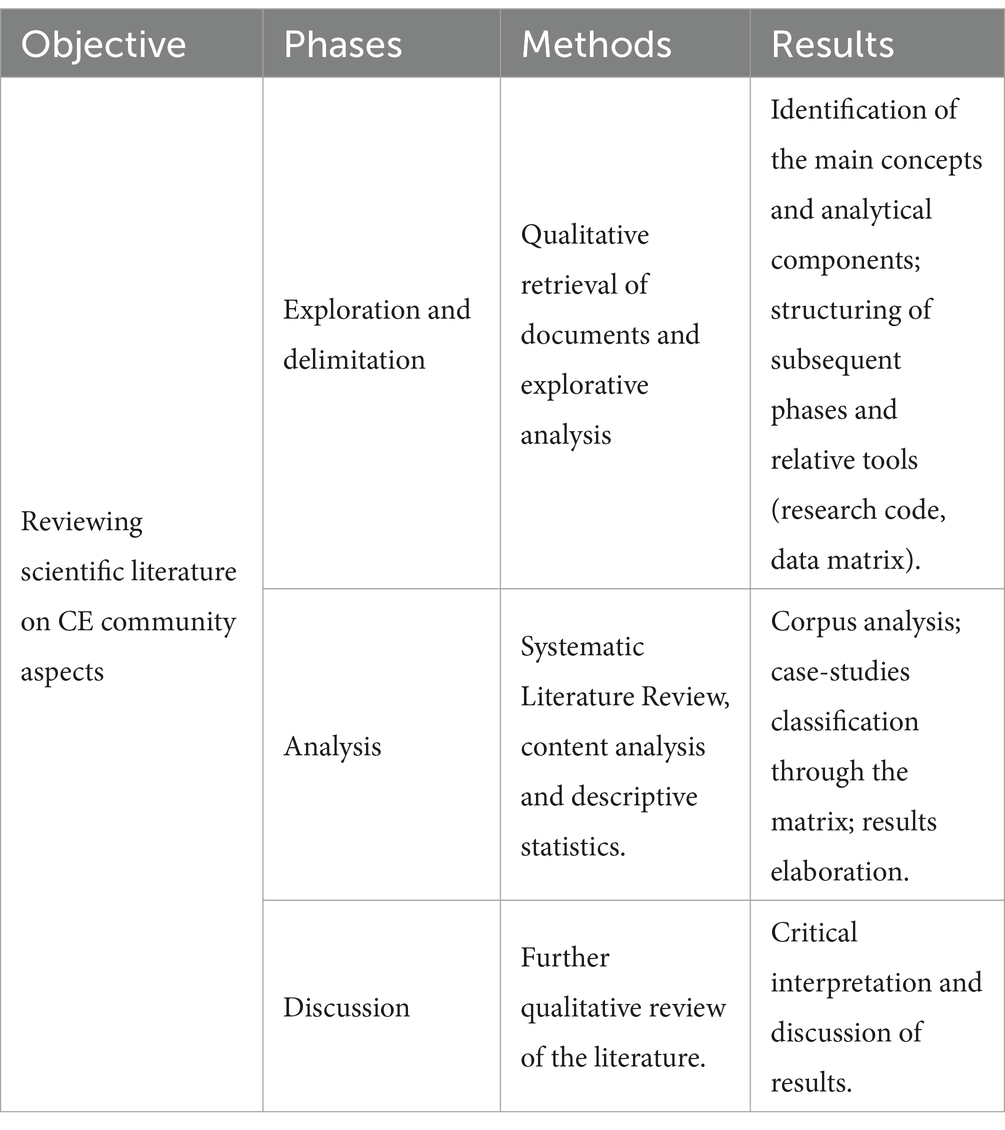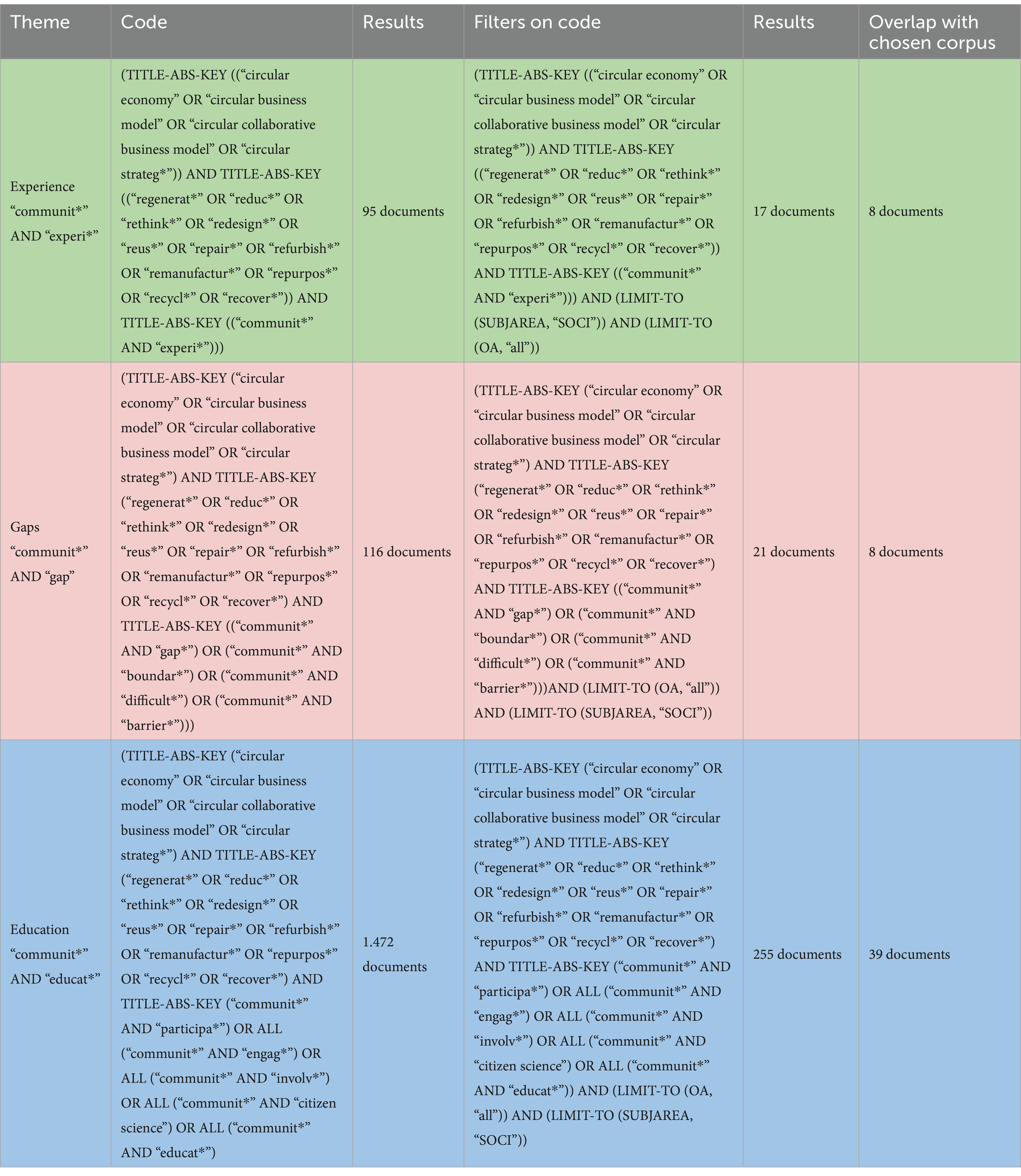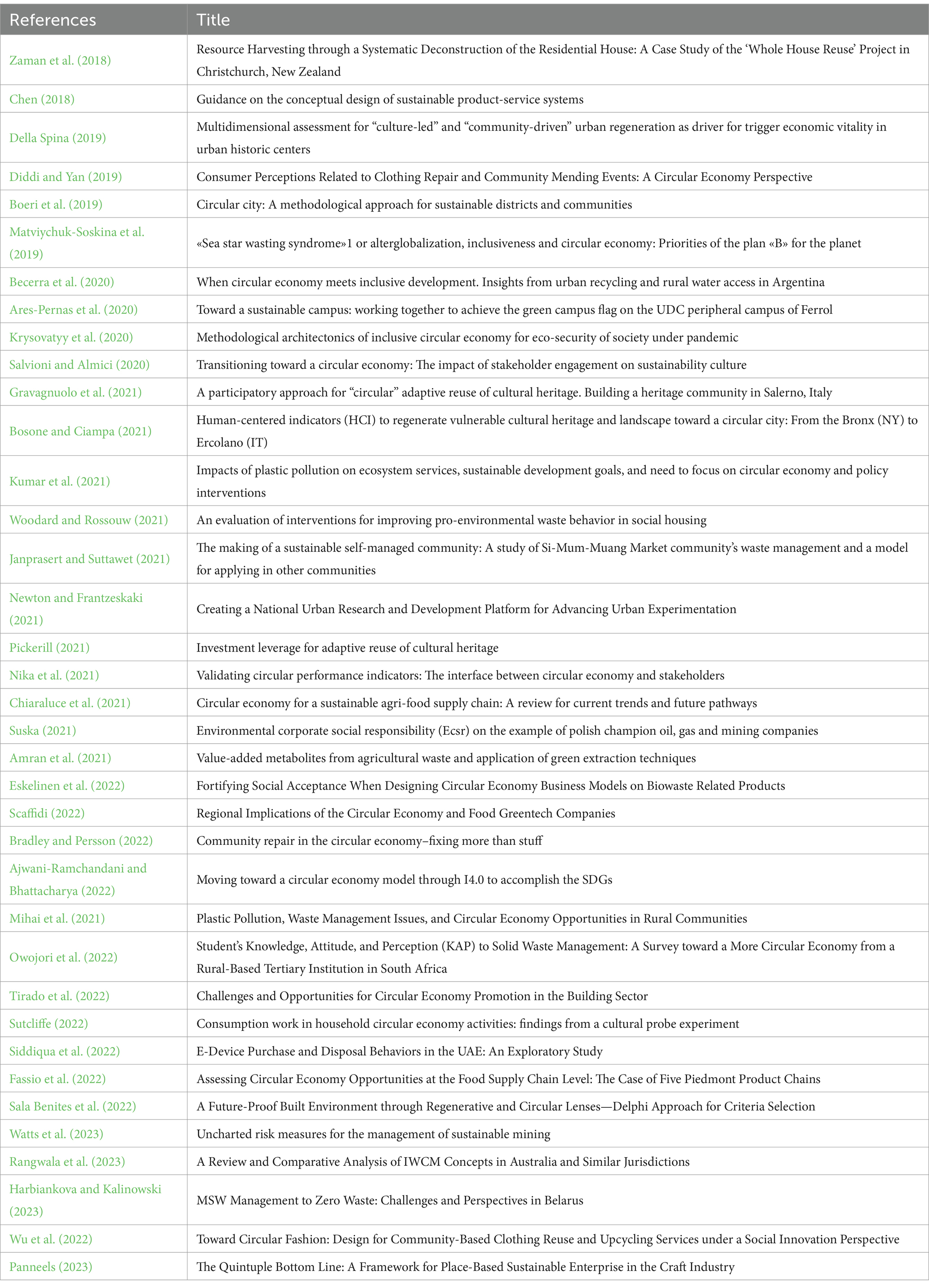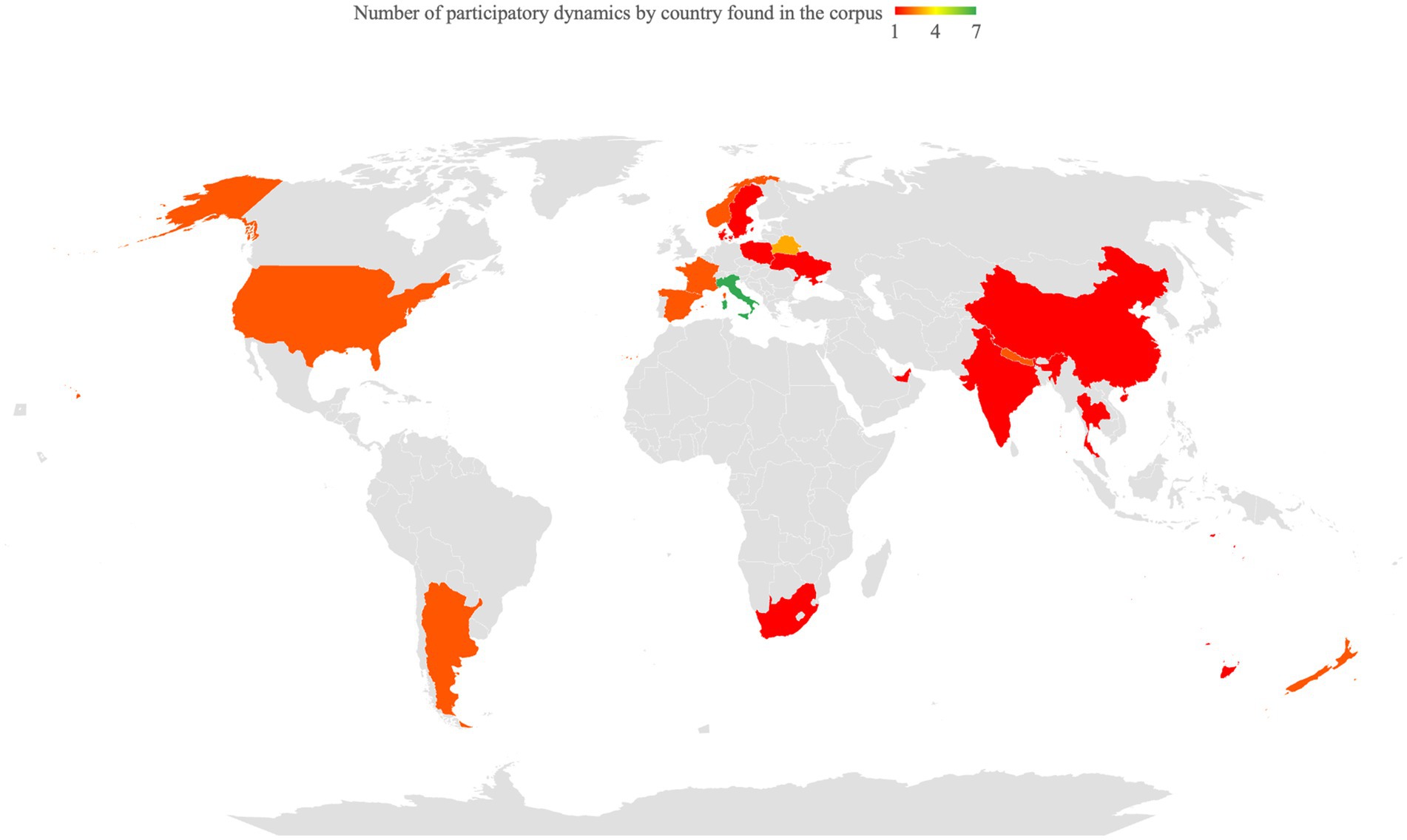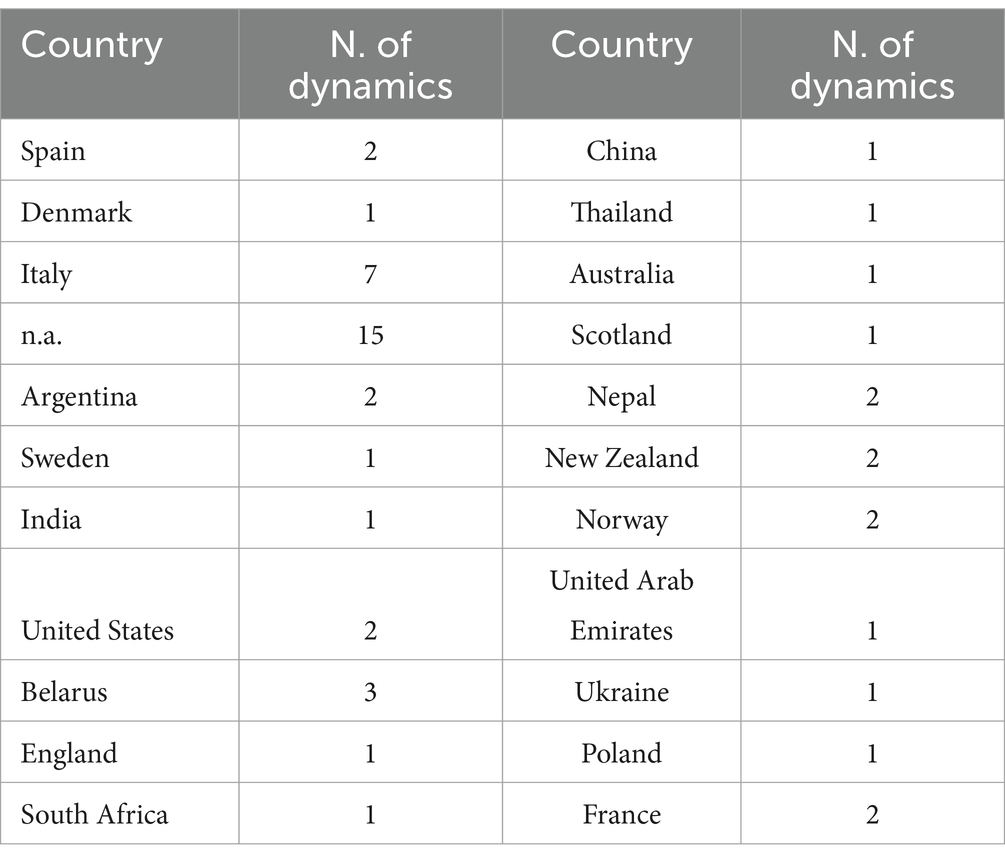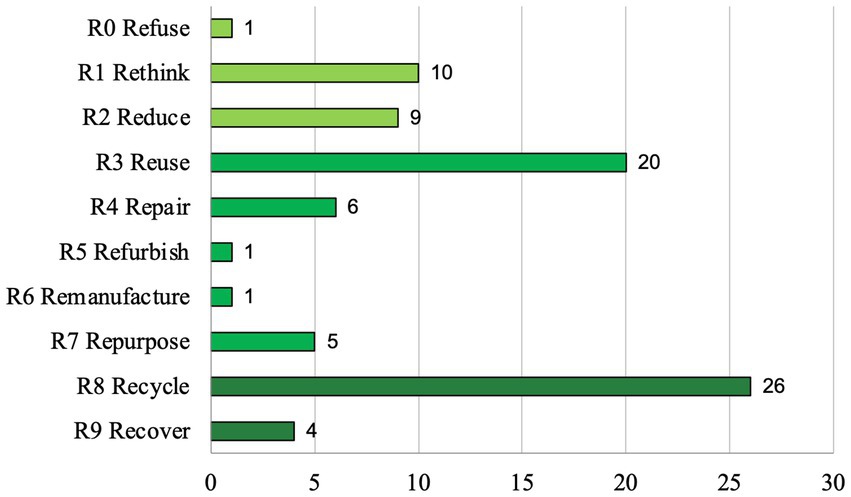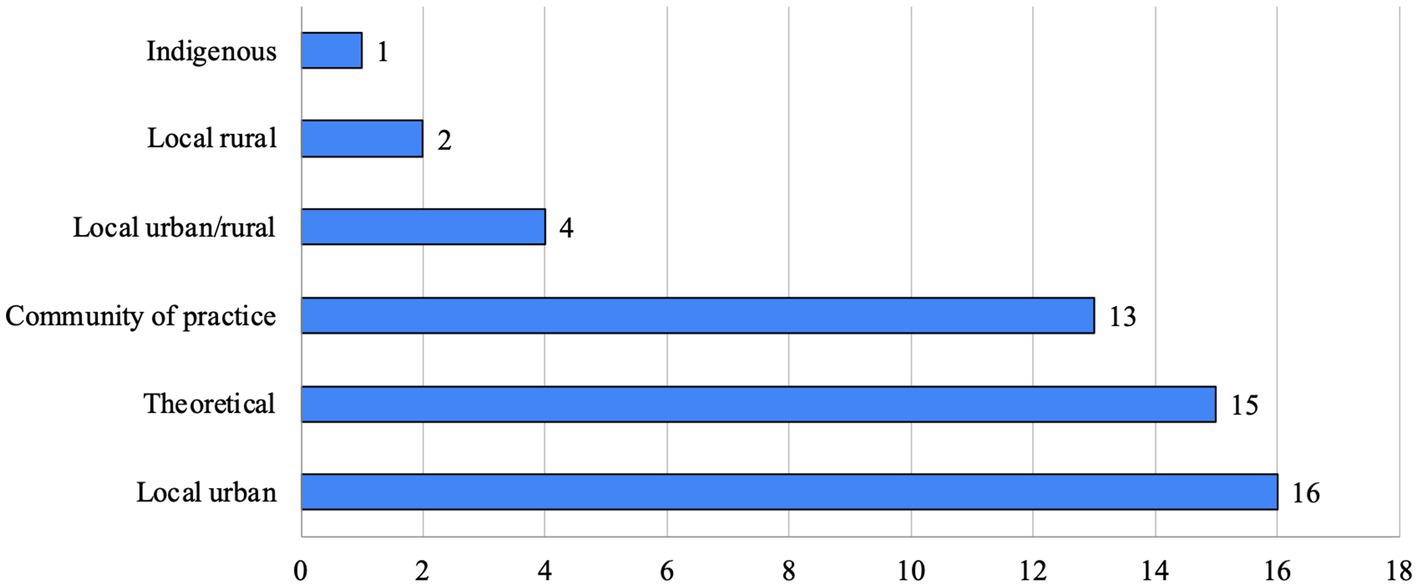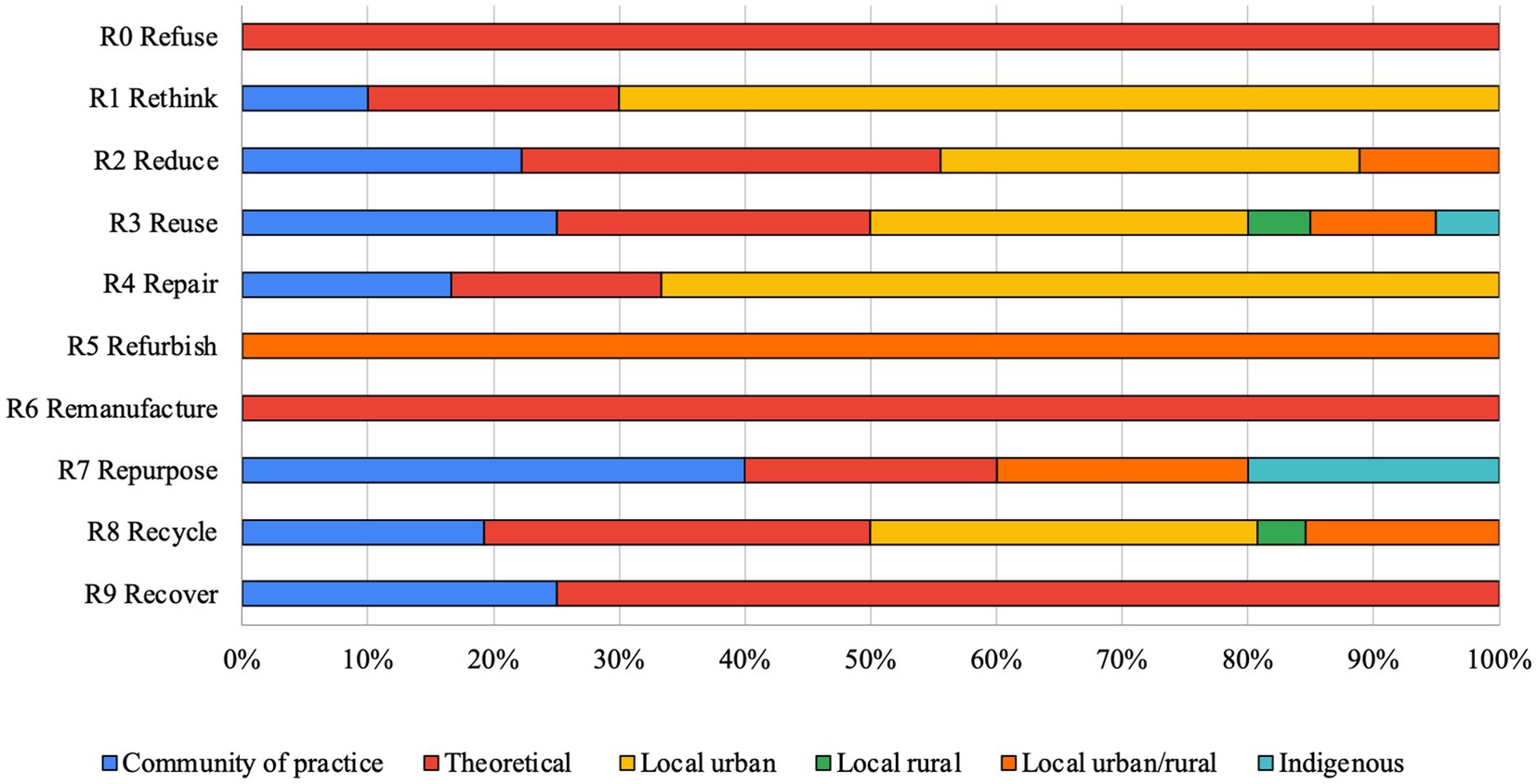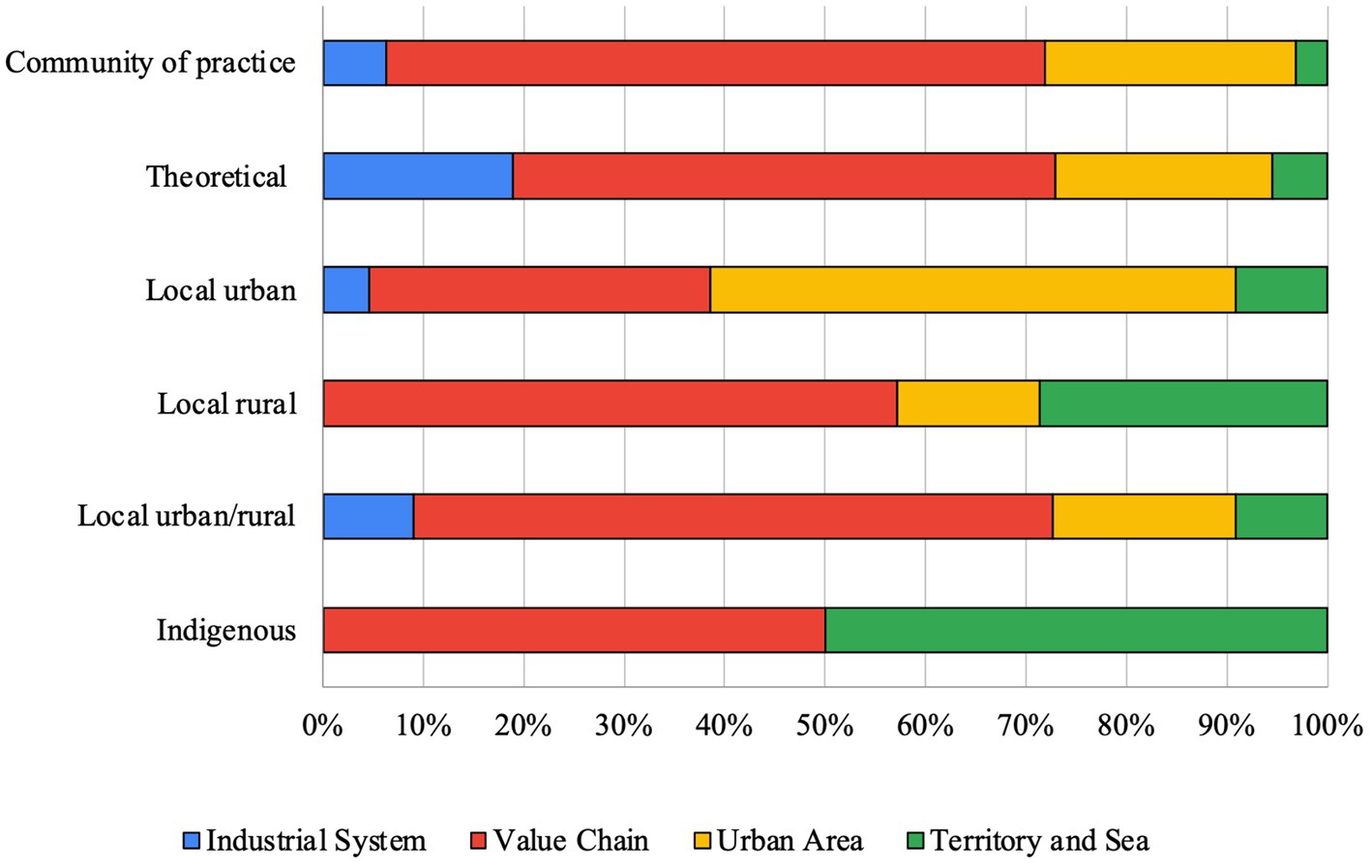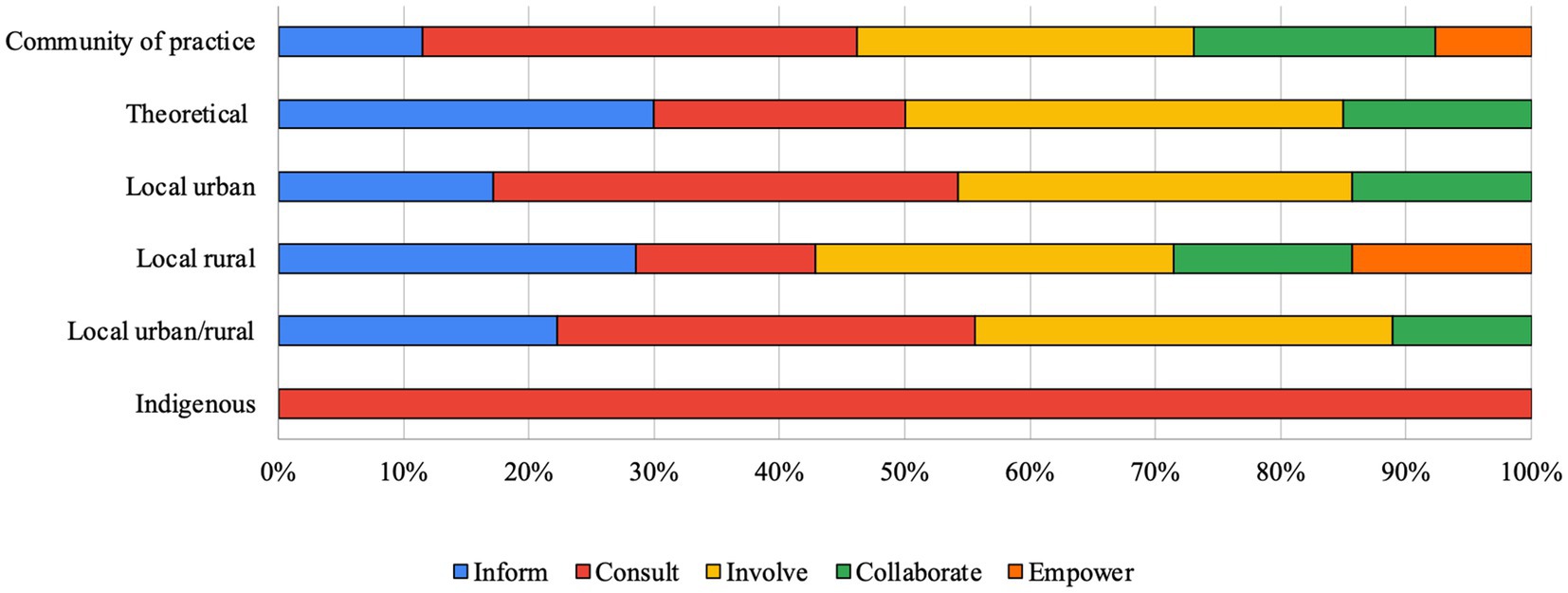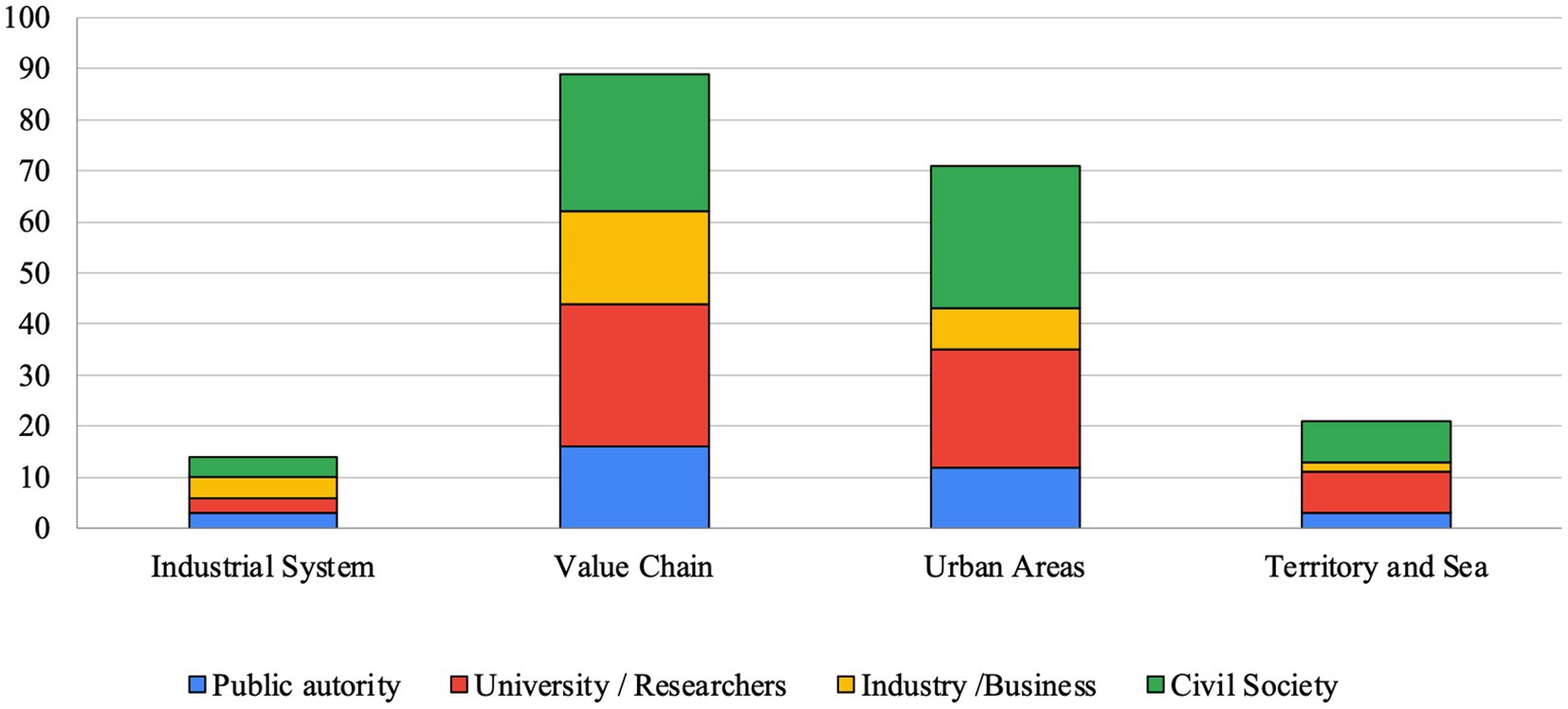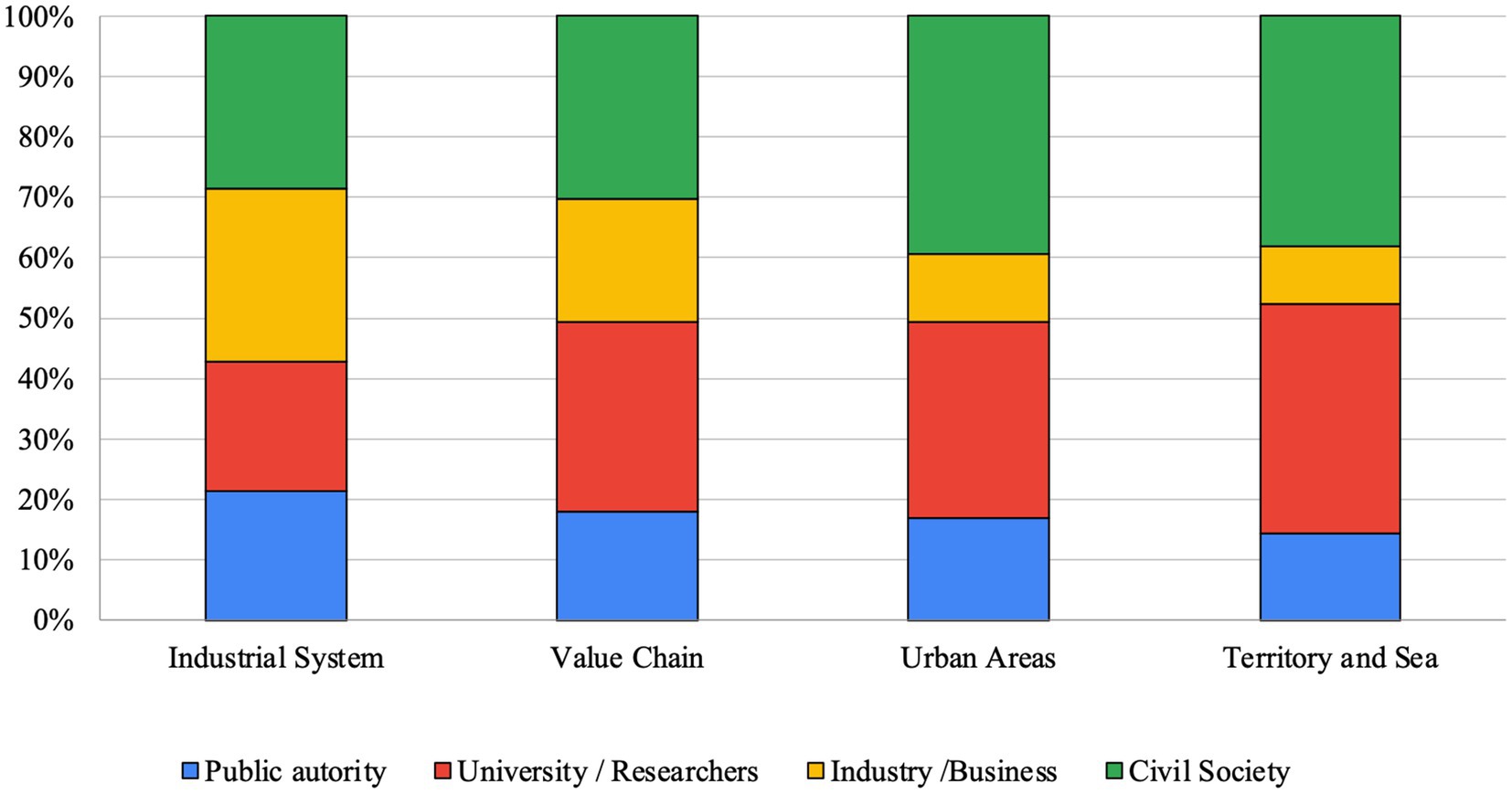- 1Department for Sustainability, ENEA-Italian National Agency for New Technologies, Energy and Sustainable Economic Development, Casaccia Research Centre, Rome, Italy
- 2Support for Coordination of Activities on Circular Economy Section, Department for Sustainability, ENEA-Italian National Agency for New Technologies, Energy and Sustainable Economic Development, Casaccia Research Centre, Rome, Italy
- 3Support for Coordination of Activities on Circular Economy Section, Department for Sustainability, ENEA-Italian National Agency for New Technologies, Energy and Sustainable Economic Development, Trisaia Research Centre, Rotondella, Italy
Circular Economy (CE) studies often focus primarily on technical and economic aspects of the transition process. Recently, some authors have started to enquire the social processes connected to of the CE, often referring to communities. This article provides a Systematic Literature Review on the nexus between CE and community to investigate its features according to the experiences reported in the collected documents. The retrieved corpus has been analyzed recurring to consolidated frameworks, as the R hierarchy, the societal areas challenges identified by the Strategic Research and Innovation Agenda developed by the EU project CICERONE, and to the spectrum of participation provided by the International Association for Public Participation. The participative dynamics found in the corpus are analyzed also considering the type of communities, tools, methodologies and goals reported in the retrieved documents. Besides descriptive statistics about the mentioned aspects, the article includes a discussion on some CE social aspects, problematizing and questioning the retrieved stakeholders engagement practices, recurring to a qualitatively selected literature. Conclusions address the main findings related to the most commonly found R strategy, community type, societal challenge areas and type of participative dynamics according to the analytical components chosen in the methodology. Research implications are illustrated, suggesting possible directions for future research to widen the analysis on the nexus between CE and communities.
1 Introduction
Ideally, Circular Economy (CE) denotes a self-regenerative economic system aimed at optimizing resource consumption and at minimizing society’s environmental impact (Ellen MacArthur Foundation, 2013). In CE, all products and services are designed to last as long as possible, while every productive loop is closed through materials re-use and waste recycling. Moreover, CE may contribute to the reduction of virgin material extraction by 34%, as well as reducing greenhouse gas emissions, and limiting the global temperature increase within 2°C (Circle Economy, 2023). The transition to a CE would effectively contribute to the implementation of the Agenda 2030 (United Nations, 2015) and the achievement of Sustainable Development Goals (United Nations, 2017). CE is extensively addressed by the European and national institutions in their strategic documents and policy, such as the European Green Deal (European Commission, COM/2019/640 Final, 2019), the EU Circular Economy Action Plan (European Commission, COM/2020/98 Final, 2020) and, at the National Italian level, the Italy’s Circular Economy National Strategy (Ministro Della Transizione Ecologica, 2022, n. 259). Hence, implementation of CE is both about compliance mechanisms and about visioning of alternative futures and co-constructing alternative pathways to development. Notwithstanding the rising interest in CE knowledge and practices, some authors have highlighted that in 2023 only 7.2% of the current global economy is circular (Circle Economy, 2023; Fraser et al., 2024), and this share has decreased over the last years (being 9.1% in 2018). Such a decrease is partially due to the current poly-crisis scenario (Lawrence et al., 2023), in which the post-pandemic economic crisis, together with the dramatic geopolitical turmoil in Ukraine and Middle East, altered the price and the international flow of energy and raw materials, pushing many economies back to the linear model to reduce production costs. Hence, nowadays CE transition is hindered by diverse systemic obstacles posed by the linear model, that sees CE as a threat to profit accumulation. As such, CE represents a radical alternative to the linear ‘take-make-dispose’ economic model, which relies on an unsustainable consumption of energy and resources, while producing waste that poses dramatic environmental damages.
Nonetheless, fostering the circular transition is an ambitious task that requires efforts, not only in terms of technological and scientific development, but also on the financial, political, cultural, social and organizational levels. Social aspects and concerns are emerging in the literature developed around the circularity principle and CE definitions (Kirchherr et al., 2017; Korhonen et al., 2018; Arruda et al., 2021). For instance, it has been noted that challenges occur on multiple levels and at different scales (Ulgiati and Zucaro, 2019), questioning how public governance and networks can lead an efficient CE transition (Cramer, 2020; Cramer, 2022). Context is still identified among the factors that may influence implementation of circular loops at the city level (Williams, 2019). Other authors have highlighted the need to integrate the management aspect of material flows with other dynamics present in urban contexts (Zucaro et al., 2022), taking into account external changes (Cristiano et al., 2020), while other studies, reports and policies are increasingly urging to adopt a multi-actors perspective and stress how important is the contribution of different actors is in making circular shift more effective and successful (Circle Economy, 2023). In this sense, it would be important for institutions, companies and other financial actors, researchers, and civil society to develop a cultural change and strengthen a common vision of CE and its implementation. Networks and stakeholders engagement have been discussed in the frame of CE (Kujala et al., 2023), being considered both in relations to value added by stakeholders in “institutions and governance norms” (Albareda and Kimpimäki, 2023) and as effective modalities to overcome diverse types of challenges, building consensus or identifying specific needs to be addressed.
While the term community recurs frequently in CE studies, the perspective on community dimension can be refined and expanded, as this expression is often overlooked, or addressed generically. This lack appears more evident when considering other forms of social innovations. For example, in the energy field, many “renewable energy communities” (Creamer et al., 2008) officially exist and are fully operative, while an equivalent institution or recognition for CE is still missing. Research on the formulation and development of new actors (e.g., “community enterprises,” Bauwens et al., 2022a,b) showed the transformative power of language in shaping social practices, while other authors have highlighted the aspects of decentralization and democratization when discussing renewable energy communities as socio-legal institutions (Heldeweg and Saintier, 2020). As of today, the need to discuss perspectives on CE and transition implementing the circular approach persists, beside what has been already identified in other research fields, as in sustainable transition (Loorbach et al., 2017). There seems to be a lack of convergence, both in scientific literature and among institutional policies, toward a definition of “circular community.” When found in the literature, this expression is employed to generically address the relationship between CE and communities which, in turn, is treated from many different perspectives.
This paper provides a Systematic Literature Review (SLR) aimed at exploring and describing the ways in which the nexus between community and CE paradigm is deployed in several research materials, identifying the different connotations and uses of such a nexus. The research results relevant also in the light of the argument made by Kirchherr et al. (2023), namely that CE has progressively become a new and proper research field. The research questions formulated for the study are the following: how is the term community deployed in the scientific literature addressing CE themes? What kind of communities are included in the scientific literature? Where are communities located and what at are their features? Is there any circular strategy or practice that could be associated to communities? What kind of participation is activated, and by whom? What are the main tools and methodologies for community involvement in the CE? To present the results of the research, the paper is structured as follows: (i) in section two “Methods,” the authors illustrate the research design, methodology and techniques, as well as the analytical components which have been selected to undertake the analysis; (ii) in section three “Results,” a description of the findings according to the analytical components selected is provided; (iii) in section four “Results,” findings are framed, discussed and critically interpreted, recurring to a qualitative literature review; (iv) finally, in the section “Conclusions,” the essential findings are remarked to address future research.
2 Methods
The design of the research activity included the combination of both quantitative and qualitative methods. As such, this study can be virtually situated in the mixed methods review category (Grant and Booth, 2009). The research is structured in three main stages, which are illustrated in the following paragraphs.
2.1 First stage: exploration and research design
The research started with a first stage of qualitative exploration of the literature around the expression “circular community.” This attempt revealed only one relevant document including the mentioned expression (Niero et al., 2017), referring to the Carlsberg Circular Community, that is a cooperative platform through which the world-wide brewery and its global partners developed an optimized packaging to improve circularity. Although this paper seemed highly pertinent and promising to explore the social dimension of a circular community, the document focused on technical aspects of eco-efficiency and eco-effectiveness related to productive innovations, rather than other dimension, e.g., community relations. For this reason, the authors expanded the research beyond the specific expression “circular community” (Niero et al., 2017), enquiring about the more general relationship between CE and communities. However, during this second step the opposite problem immediately arose, as the exploration proceeded throughout an extensively variegated literature. Therefore, it was decided to narrow down the research, investigating the relationship between the circular approach and community through the Systematic Literature Review (SLR) methodology, which represents the second phase of this research, described in the following section. The adoption of this method was inspired by research materials found at the initial stage as the study of Mies and Gold (2021), focusing on the social aspects of CE, and the Joint Research Center report on EU publications (Baldassarre and Saveyn, 2023). Both provided insights and methodological guidance on how to conduct the SLR on the research object of this paper. Other documents obtained in this initial stage allowed to delimit the subsequent systematic search and to structure the analytical components into a data matrix.
To narrow down the CE field and to structure the search code, the so-called R framework (Kirchherr et al., 2017; Morseletto, 2020), was taken into account, except for “Refuse,” whose analysis and discussion would have exceeds the limit of the present work. Still, the breadth of topics in the CE related literature led this research to focus on the economic dimension, and particularly on the emergence and consolidation of new business models, that have been included in the research code. For what concern the circular strategy, the chosen framework to manage the variety of arguments into the CE literature is provided by the EU Horizon 2020 project CICERONE1 that aims at bringing together “programme owners, research organisations and other stakeholders to create a platform for efficient Circular Economy programming.” In particular, CICERONE “is developing a circular economy strategic research and innovation agenda (SRIA), a strategic guidance document on circular economy in the context of the European Union (…) that build on four societal areas that face sustainability challenges (…) to tackle EU region-wide issues and facilitate the transition to a circular economy”.2 Hence in this study, these four societal areas (namely: urban areas, industrial systems, value chains and territory and sea) have been adopted to frame the SLR documents.
As for the community dimension, the authors chose to focus on its participative dimension in CE experiences. As illustrated by Luigi Bobbio (2019), different classifications apply to the wide concept of participation. While being aware of the non-exhaustiveness of this tool, following Ross et al. (2016), the “spectrum of participation” developed by the International Association for Public Participation (iap2, 2023) (IAP2)3 has been selected as an effective tool to frame different participation experiences for the scope of this paper. Further information about this tool can be found in the next paragraph. The search code also includes a reference to citizen science, meant as an innovative participative dynamic to involve individuals from the civil society in technological and scientific activities that is gaining floor into the CE (Presenti et al., 2020). Finally, the SLR identifies the main actors involved in the participative dynamics, recurring to the quadruple helix model (Carayannis and Campbell, 2009; Carayannis and Campbell, 2010).
Therefore, through the first exploration conducted, the authors have outlined the research design including three phases. The first phase dedicated to a specific exploration and delimitation of research and undertaken by adopting a qualitative selection of documents; the second phase dedicated to the analysis of the materials retrieved by implementing the SLR, and the phase dedicated to the discussion of the evidences by recurring to qualitative elements deriving from the literature. Beside the methods selected, the authors have identified specific results achieved at the end of each phase, as reported in Table 1.
2.2 Second stage: systematic literature review
The documents for the SLR implemented in the present work were collected between July and September 2023.
2.2.1 Coding of the search query
The code used for querying the database (Elsevier’s Scopus) is the following:
(TITLE-ABS-KEY (((“circular economy” OR “circular business model” OR “circular collaborative business model” OR “circular strateg*”) AND (“regenerat*” OR “reduc*” OR “rethink*” OR “redesign*” OR “reus*” OR “repair*” OR “refurbish*” OR “remanufactur*” OR “repurpos*” OR “recycl*” OR “recover*”) AND ((“communit*” AND “participa*”) OR (“communit*” AND “engag*”) OR (“communit*” AND “involv*”) OR (“communit*” AND “citizen science”))))) AND (LIMIT-TO (SUBJAREA, “SOCI”)) AND (LIMIT-TO (OA, “all”)).
By addressing the presented query, the database returned documents that include, in their title, abstract or keywords, a combination of elements, namely: a reference to CE (either generical or more focused on business modeling), to the R hierarchy, and to the participative dimension of communities. The code provides a limitation of the research, focusing on the social area or subject, as well as Open Access documents. This limitation reduced the available corpus from an amount of 169 to 42 documents, whose abstracts have been screened to assess their pertinence in relation to the scope of the research. Five documents were excluded for the following reasons: one was in Spanish language, while the remaining four did not address CE punctually, or overlapped it with other fields (e.g., bioeconomy, sharing economy). Accordingly, the ultimate corpus for this SLR consists of 37 documents. The process is illustrated in Figure 1.
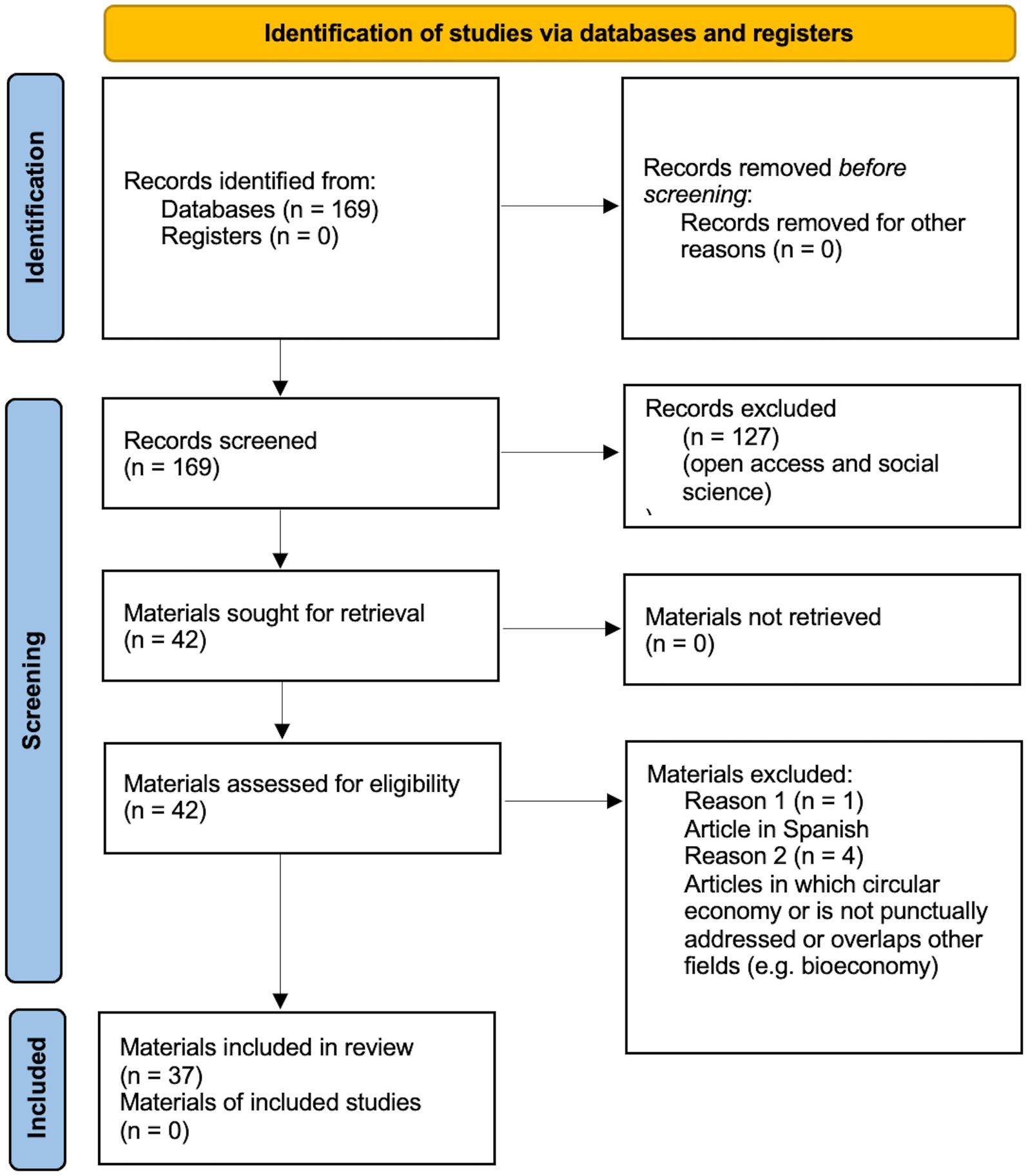
Figure 1. SLR PRISMA diagram adapted from Page et al. (2021).
As the analysis proceeded, it seemed that the corpus of the research was mostly made of theoretical studies, lacking concrete community experiences and their critical interpretations. For this reason, the authors tried to assess whether the code was excessively biased toward specific dimensions of CE, thus excluding articles more focused on its socialization aspects. For these reasons, some additional attempts and queries (Table 2) were conducted, integrating the original code with new keywords, such as “experience,” “gaps,” and “education,” in order to explore different themes and corpora, and to assess possible overlaps with the original corpus, as showed in the dedicated columns reported in Table 2.
These further queries showed some overlaps with the original corpus, suggesting that this latter sufficiently addressed concrete community experiences, their gaps and their social dimension. The final corpus includes the documents listed in Table 3.
2.2.2 Combination of frameworks to analyze the corpus
Once the corpus of 37 documents has been obtained, a content analysis has been implemented, using a data matrix including the identified variables, that emerged from the framework selected in the first stage. The variables, grouped in sections, are presented in details as follows:
(a) Documents information:
○ author(s),
○ title,
○ year of publication.
(b) Circular economy:
○ 10Rs framework (Kirchherr et al., 2017). This framework allows to classify circular experiences consistently and uniformly. The ten actions of the R framework cover a wide range of circular strategies, allowing for the capture of a broad spectrum of circular experiences present in the literature. The authors included in the query code all the Rs, except for “refuse,” namely:
■ Reduce, rethink, redesign, reuse, repair, refurbish, remanufacture, repurpose, recycle, recover
○ Domains of societal CE challenges (framed by the CICERONE project):
■ Industrial systems: this domain “addresses the efficient use of resources and the sustainable production through the implementation of innovative technologies and tools at the level of individual factories, industrial areas or industrial networks” (EU Circular Cooperation Hub, 2020, p. 105).
■ Value chains: this challenge “covers the main topics for closing the loop of specific materials (e.g., Critical Raw Materials or others), products (e.g., plastic packaging, WEEE, tyres, etc.) and in specific supply chains (such as buildings, agro-industry, textile, etc.). Within this challenge all value chain phases need to be taken into consideration: design, material supply and production, consumption and distribution and end-of-life as new production of materials” (EU Circular Cooperation Hub, 2020, p. 107).
■ Urban areas: this theme “focuses on increasing circular flows of materials and energy in cities in order to improve consumption efficiencies and minimize waste, thereby reducing negative sustainability impacts” (EU Circular Cooperation Hub, 2020, p. 104).
■ Territory and sea: this domain addresses “the complex relationships between mainland human activities and the open water, chiefly represented by the techno-sphere environment of harbours” (EU Circular Cooperation Hub, 2020, p. 108).
(c) Community:
○ Typology:
■ Local community: refers to a group of people whose primary bond is the sharing of the same territory (Gallino, 1978, p. 152). It includes the following subcategories:
■ Urban community, if the shared territory is urbanized.
■ Rural community, if the shared territory is rural.
■ Urban/rural community, if the kind of shared territory is not specified.
■ Indigenous community, if, alongside the dimension of a shared territory, there is a historical dimension such that community members hold and share traditional knowledge and techniques (Watson, 2020; Panneels, 2023).
■ Community of practice: this expression indicates social groups (usually of modest size) kept together by certain common characteristics or interests that give rise to specific practices (Wenger et al., 2002). A community of practice may either share the same territory, thus being a local community too, or not, gathering together only in specific moments or even virtual places.
■ Theoretical communities: the authors decided to use this expression when an article addresses circularity and community issues in theory, without locating the community in a specific territory.
○ Location: the country in which the community is located, if any.
(d) Participation:
○ IAP2’s spectrum of participation, this tool “was designed to assist with the selection of the level of participation that defines the public’s role in any public participation process. The Spectrum is used internationally, and it is found in public participation plans around the world.”4 The spectrum includes classification of participative experiences, as follows:
■ Informing: at this stage, communication is one-way. The public is provided with information but is not actively involved in the decision-making process. Newsletters, websites, articles and lectures are typical tools used at this level.
■ Consulting: opinions, concerns, suggestions and knowledge are gathered from the public, for instance through surveys and interviews but the decision is still held by the authorities.
■ Involving: the public is involved in the decision process, joining discussions, workshops or forums. Public opinions are heard, but the final decision is still taken by the authorities.
■ Collaborating: at this stage, decision-makers seek the public’s consensus and collaboration. Both parties influence the outcome and co-develop solutions.
■ Empowering: the decision is taken by the public.
○ Aim of the participation process
○ Tools and methodologies employed
■ interviews, surveys, focus groups, living labs, etc.
○ Quadruple helix actors
■ Public authorities as institutions, central and local public administration; Actors involved in education, research and innovation field, Actors in the private sectors as Companies and trade associations; Citizens, civil society and organization in the third sector.
○ Impact of the participative process on the community
■ The impact considered are ecological, social, political, economic impacts
2.3 Third stage: critical interpretation through selected readings and materials
Following the implementation of the SLR, a further qualitative literature review was carried out. The aim of this third stage was to address, with more in-depth sources, some of the major lack identified in the corpus, where the theme of community participation is often merely mentioned, taken for granted, or discussed in a simplistic manner. Drawing on sources from Stakeholders Engagement studies and more broadly from social sciences, we problematized and delved into the relational and participatory dynamics, showing that the CE community dimension deserves more attention, at both theoretical and practical level, taking into account also the recent CE research trends and directions identified within the selected materials and other studies, as the one conducted by Khitous et al. (2020).
3 Results
Before presenting the main results of this SLR, it is useful to recall the high heterogeneity of the final corpus that was obtained. Made of 37 documents, the corpus featured a large array of subjects, theoretical perspectives, empirical approaches and tools, themes and epistemic objectives. Such heterogeneity suggests that community and participation are very transversal issues but, at the same time, that an established research line about CE and its community dimension is still lacking. Thus, as a specific stream in the CE literature dedicated to circular communities is still missing, the available documents are very dissimilar and non-specific. On the contrary, throughout the corpus of this research, it often came across participatory dynamics that were just quoted, invoked, or barely addressed. Being aware of the characteristics of the corpus, as the variety of the themes or the perspective of analysis, just to mention a few, the authors have decided to adopt consolidated frameworks, both for the CE and the participation field. As previously said, framing very different processes and concepts into more established frameworks has been a challenging but necessary task in attempting to depict an overall picture of the community dimension in the CE. Given that some of the 37 documents refer to more than one participative process, a total of 51 participation dynamics emerged from the corpus. These dynamics are either empirically or theoretically addressed. In the latter case, the articles do not analyse any concrete participatory experience, but their author(s) recall(s) or reflect(s) on the community and participation.
In the following paragraphs, the main results are illustrated and provided in order to respond to the research questions indicated above. The results are presented in the following way. The first results refer to the spatial localization of the communities, followed by the results on the main circular features detected according to the Rs frameworks, the typologies of community, detection of participants and actors involved, objectives, tools and impacts of the participative dynamics.
3.1 Geographical distribution of the participation dynamics
The geographical distribution of the identified participatory dynamics is presented in Figure 2 and Table 4.
It can be noted that the corpus covers all continents, allowing for an international overview of community issues in the CE. However, it is noticeable how the corpus presents that most of the participatory dynamics in Europe, and particularly in Italy. On one hand, this suggests that Europe and Italy are represented as major players in the circular transition, even for what concerns its social and community dimension. On the other hand, there are other factors that might lead to different considerations. For instance, it should be taken into account that some countries produce less literature in English than others. In this sense, writing the query code with English expressions might have distorted the actual availability of documents addressing the CE community aspects, as well as their geographical localization. In addition, it is important to highlight that 15 participatory dynamics do not have a geographical location.
3.2 Distribution of Rs in the corpus
As these participatory dynamics are activated within the framework of projects, initiatives, or good practices in the CE, the so-called R framework (Kirchherr et al., 2017) was selected since provides a variety of R strategies. The analysis lead to the identification of one or more Rs for each analyzed process. In absolute terms, the frequency distribution of the Rs is represented in Figure 3. The bars in the figure are colored in three shades of green, in accordance with the grouping adopted by Kirchherr et al. (2017, p. 224).
In line with findings from other types of research (see for instance Mastroeni et al., 2023), it can be observed that the most recurrent strategy in the corpus is recycling, followed by reusing, rethinking, reducing, repairing, repurposing, and recovering. Instead, refusal, refurbishment, and remanufacture strategies have a more marginal frequency.
3.3 Distribution of community types in the corpus
Moving to the community dimension, despite the wide diversity of participatory experiences or theoretical approaches, the analysis of the corpus has identified some recurring types, which has been outlined in the previous paragraph. The absolute frequency of each type of community is illustrated in Figure 4.
It is evident that the most recurring type in the corpus are urban local communities, indicating that cities are laboratory settings for the circular transition. References to rural and indigenous communities are rarer, while several documents address communities of practice, i.e., those communities in which the territorial dimension of the group is less relevant than the pragmatic one. Communities of practice include groups of people joining thematic and volunteer associations or belonging to specific professional groups.
Another relevant element to point out is the widespread presence of “theoretical” communities. Specifically, out of a total of 51 participatory dynamics, 15 are characterized by the lack of an empirical approach to real and concrete experiences. In those cases, the authors either emphasize how important and useful is the activation of participatory processes in order to foster circularity, or they analyze the various components and stages of participatory involvement from a theoretical perspective. This indicates a clear and widespread attention to understand and address the issue of community participation in the circular transition. However, without analyzing concrete participatory experiences, there is the risk of generalizing aspects inherent in participation, taking opportunities for granted even when some essential conditions are lacking in the current state of affairs. We will come back to this point later, in the Discussion section, where we will delve into the aspects of participation recurring in stakeholders engagement studies.
3.4 Crossing variables: Rs, communities, societal areas, participation grades, and actors
Coming back to the results of the SLR, it seems interesting to cross the different variables considered. For example, by crossing the types of communities with various CE strategies, one can observe which R recurs the most in a certain type of community or, conversely, which type of community most frequently corresponds to the various Rs, as illustrated in Figures 5, 6.
Even more meaningful results emerge from crossing community types with the CICERONE project’s approaches societal areas, see Figure 7.
First, it is interesting to note that the most balanced distribution of approaches falls into the “theoretical” communities. The level of abstraction may have extended the possibility for the authors of these cases to focus on different aspects of the transition. Furthermore, the highest interest in “industrial system” is recorded in the same category, where it was found in 7 out of 12 occurrences. This could be interpreted as a signal not particularly encouraging, given that the involvement of existing communities in this crucial area is less frequent (5 aggregated occurrences). The distribution appears more unbalanced in other types of communities. Due to the low absolute values of other categories, this research will focus on the unequal distribution of CE approaches in the urban and practice communities. In these latter, in particular, there is a predominance of the value chain approach, probably because social groups with specific interests in environment and circularity are mainly involved in Rs practices as reusing, recycling, repairing, and rethinking, which are activities positively impacting the life cycle of products and, thus, their value chains. Moving to urban local communities, it is not surprising that the favored focus is on urban areas, meant as areas to be redesigned and regenerated through a participatory approach.
Another elaborated combination is the one regarding the community types and participation grades. This concept was operationalized recurring to the IAP2’s spectrum of public participation and reported in Figure 8.
What emerges here is that the lowest grade of participation, i. e. information, is most frequently associated with theoretical and local communities, while references to information are much rarer looking at the communities of practice. A plausible explanation could be that communities of practice consist of individuals bound by a thematic interest, thus representing groups that are already informed whereas, at the contrary, when researchers discuss about theoretical communities in their analysis, they tend to associate to these groups the need of being educated and informed. In a similar but opposite fashion, the consultation stage looks particularly frequent among the communities of practice, probably because these latter hold a strong know-how, similarly to the only indigenous community found in our corpus. Urban communities are more often consulted than the rural ones, probably because cities represent a more complex and challenging environment. In general, with 31 occurrences, consultation is the most common participation grade.
The relative distribution of the involvement and collaboration grades looks quite balanced among the various kind of communities, except for the indigenous one, with the involvement grade ranging from 25.9 to 35%, and collaboration from 11.1 to 18.5%. It should be noted, however, that the involvement grade is lower than the collaboration grade, but more frequent in absolute terms. Collaboration occurs 15 times, which is half of the involvement’s occurrences (30). Empowerment, which is the highest grade of participation, occurs quite rarely, concerning some community of practice in two cases and, only in one case, a rural community. In other terms, the result indicates that in the corpus the lower grades of participation occur more frequently than the higher ones.
Another essential element of the participation dynamics is represented by the social actors identified within the quadruple helix model. Here it was found that the most stimulating combination is with CICERONE’s approaches, reported in Figures 9, 10.
Civil society and researchers are present in each CE area (all values are above 25%, except for University in the Industrial system, which is at 21.4%), while institutional and economic actors are less involved, especially in the “Urban areas” and “Territory and sea” domains. Considering the public nature of these areas, it would be desirable to see a greater engagement of local authorities. Involving economic actors would be useful too, as spreading good practices would improve the quality of life in urban and natural areas as well. Entrepreneurial participation could be expand starting from its closer ambits, such as industrial systems and value-chains. Here, in particular, we count only 18 participative dynamics that involve industrial actors, covering only the 20.2% of the total, while their contribution would be essential to create and develop circular solutions to close productive loops in the value chains.
3.5 Objectives of the participation dynamics
Looking at the objectives of the participative dynamics that has been analyzed, it is worth to highlight that, being made of scientific papers, the corpus mainly addresses the relationship between CE researchers and communities that were specifically engaged for research purposes, while participation dynamics activated by other institutions with different purposes are thus much rarely present. However, the authors carried out a qualitative and interpretative analysis of each document from the corpus, in order to identify and classify the stated objectives. Following a cross-validation among the authors, the participative objectives have been grouped. However, besides the document composition in the corpus, the participative goals may be distinguished into the following categories:
• Instrumental objectives: a first category of participative goals consists in activating communities to improve the acceptance and reception of circular solutions that have already been designed by institutions, companies, researchers or other actors. The participative dynamics belonging to this category aim at increasing the consensus around circular innovations or at favoring some behavioral changes toward specific solutions. In such cases, participation can be said to be “instrumental,” meaning that communities are activated, usually with a low participation grade (such as information or consultation), in order to facilitate innovations’ diffusion and success. This kind of participative goal is often present in documents addressing theoretical communities rather than the empirical ones. However, in these cases, the community is supposed to act merely on itself, thus representing the object, rather than the subject, of a participative dynamic whose main interest is to promote some pre-determined circular solutions.
• Functional objectives: in the second category, the participative goal is not depending on ready-made circular solutions but, at the contrary, it is free and unstructured, being “functional” to the further activation of subsequent participative dynamics. In such cases, the main goal is to favor community initiatives and social change, to plan, develop and offer services, or to develop synergies and partnerships among social actors. The community is thus conceived as a subject capable of self-activation on other and subsequent participative dynamics.
• Material objectives: this last category that was identified is made of dynamics whose participative objective consist in providing the community with cognitive and practical tools, as well as with the structures and infrastructures necessary to carry out circular actions. In such cases, participation can be said to be “material” (Marres, 2016), given that the community contribution to CE is not limited to a mono-or bi-directional exchange of information (with researchers, institutions or other actors) but it is integrated with some practical activities that concretely realize certain circularity principles. In this category, participation is framed as a practical activity, such as objects repairing, materials recovering and creative recycling, to be carried out.
• Multiple objectives: beside the objectives that can been clearly separated into these three categories, others found in the corpus rely in the middle area between the instrumental and the functional, and can be identified with the objectives inherent in the IAP2’s participation spectrum, i.e., to inform, consult, involve, collaborate, and empower. Among these, consultation is the most common objective through which community activation happens (31 occurrences out of 51 participative dynamics). Focusing on the consultation itself, a range of specific objectives can be found as stakeholders mapping, preferences, priorities and challenges identification, or the retrieval of information that cannot be obtained otherwise.
3.6 Tools and methodologies found in the corpus
Moving to the tools and methodologies used to activate the participative dynamics, the most recurring are represented by the typical instruments of social research, i.e., interviews, surveys, pools and focus groups. This is due to the prevalence in the corpus of participative experiences activated in the framework of research activities rather than circular projects or policies. Meaningfully, these tools are meant for consultation, which is the most common participation grade. Looking at project-related or political experiences, other tools emerge, such as workshops, experiential walks or visits, and other theoretical or practical exercises in which a selected groups of individuals learn through scenario simulation. Besides these research-oriented and policy-oriented tools, a third category of instruments can be identified, that includes dissemination instruments and activities such as conferences, seminars, lectures, classes, websites, videos and brochures. These tools relate to those participative dynamics which are limited to (or include) information as the main participative grade, thus involving both research and political institutions. Lastly, a fourth type of instruments might be identified, corresponding to the model of “material” participation that we just presented in the previous list. Contrary to other tools, the instruments falling into this category are not oriented toward information and/or communication, but rather to some practical circular activity. It might sound trivial, but recycling bins, physical or virtual spaces in which some activities are carried out, or the technical tools needed for repairing activities, are essential instruments to enable participation.
3.7 Impact of the participation dynamics
For what concerns the impact of the participative dynamics, two premises are needed. First, due to the theoretical richness and complexity, the impact of the participative dynamic is not extensively argued in many documents of the corpus. Among the reasons for this lack there is the fact that in some cases the published articles referred to participative dynamics still in progress, thus researchers could intercept just a part of the participative dynamic, without arriving to the phase of assessing their impact. A second premise is that when the impact was addressed by researchers it often coincides with the declared objectives of the participation process. In other words, when a document focuses on a participative experience whose objective is, for instance, to improve recycling rates, the impact is identified with a quantification of the achieved results. Considering these two premises, it is still possible to identify some main typologies of impact into the corpus.
• Ecological impacts: in this first category, impact is addressed in ecological and quantitative terms, for instance recurring to metrics of resource consumption and recycling rates.
• Social impacts: following the activation of some participative processes in such contexts, it is often observed an impact on the community itself, addressing it with expression such as “increase of proactive attitude,” “citizens’ responsabilization,” “growth of social cohesion,” or “improvement of awareness” and of “social bounds.” Other impacts mentioned are improvements in terms of education, employment and inclusiveness are often highlighted as main impacts.
• Political impacts: highlighting results such as the “overcoming of business-centric view” of the CE, its connection with political agenda and social justice issues, the strengthening of the public sector through incentives and innovation policies, or the possibility for the public to influence some administrative decisions.
• Economic impact: one last kind of impact is of economic nature. In this case, what is considered are flows of economic resources generated by the innovations, as well as the organizational transformation they brought.
Having presented the results from the implemented SLR technique, the following section provides the result discussion recurring to elements disseminated in and gathered from a wider research literature.
4 Discussion
This section is divided as follows. Firstly, a reflection on the results of the SLR is provided. However, given the specificity of the research questions, the results obtained on the whole are rather peculiar, therefore a comparison with evidences from other studies is not directly applicable; nonetheless confrontation is possible on single issues and challenges. Secondly, implications of the results for practice, policy, and directions for future research are presented. Finally, the limits of study are addressed.
Starting with the results obtained, for what concerns the geographical distribution of participative dynamics in CE gathered in this study, as illustrated in Figure 2, it can be noted that the distribution among countries is variable. Participative experiences are more documented in some countries with respect to others, however this results in line with other evidences retrieved from the article of Petit-Boix and Leipold (2018) on waste management and urban planning practices and their alignment to research. With regard to the most common type of R, recycling emerges as the most frequent one, as also noted in a previous study conducted by Schöggl et al. (2020), aimed at identifying the status and evolution of CE research between 2000 and 2019. In the corpus of the present paper, the nexus between community and the CE paradigm is deployed in different ways, also due to the different meanings attributed to CE and communities. This recalls other results emerging from diverse research, as the study concerning the case of energy communities (Bauwens et al., 2022a).
On connotations, the nexus of community and CE has been discussed also in other literature reviews. In the one conducted by Padilla-Rivera et al. (2020), it is possible to notice some aspects related to the community perspective. In their words:
“Operation of CE should increase participative democratic decision-making through a community user. Moreover, it is important to pay attention, from a stakeholder perspective, since this approach can generate better decisions that are more likely to be implemented, raise legitimacy, and promote a wider understanding of the complexity of societal problems. Participation by local actors also plays an important role in a community-centered perspective that accentuates local empowerment. Another area related to the community and involvement in decision-making is social acceptance, also referred to as community acceptance. Community acceptance involves specific acceptance of citing decisions within projects, in this case, projects related to CE, by local actors, particularly residents and local authorities.” (Padilla-Rivera et al., 2020, p. 10).
Beside those elements, what emerge from the retrieved corpus are also the features related to socio-cultural aspects not just related to the culture of consumption but also to culture in a broader sense, as in connection with creativity and heritage, that is a factor that profoundly relates with the social dimension of communities (Della Spina, 2019; Bosone and Ciampa, 2021; Gravagnuolo et al., 2021; Pickerill, 2021). In particular, from the papers that specifically investigates CE and Cultural and Creative dimension, authors include in their studies the challenge of applying circularity to the dimensions of preserving and reuse of “common” goods. Cultural dimension and cultural heritage were included in the wider discussion on social aspects elaborated by Mies and Gold (2021). In their review, these authors detected specific concerns and issues, and in particular the need of stakeholder integration in order to move further from the identification of social factors which are easily measurable and grasp multiple social aspects.
Delving into multiple social aspects may lead toward a better understanding of how these intervene in the transition process, influencing actors, stakeholders and their evolution, being already identified in the literature or resulting as new. As a step toward the study of this complexity, in relation to the objective of this paper, we identify three kinds of nexus between community and CE, that combines initial insights and evidences gathered through the literature review, namely:
• Nexus 1: CE implemented at community level, understood as spatial dimension or extension of a settlement;
• Nexus 2: Community, as a group of individuals or as collective actor, sharing or expressing orientation toward CE.
• Nexus 3: Circular community as a specific subject fully integrated in multiple layers of relations (normative, economic, social, etc.).
Nexus 1 and 2 are generally present in the literature and generally recurrent in the SLR documents, Nexus 3 results to be underexplored, as the focus remains on canonical actors included in the frameworks considered. On actors in CE, the results provided by Mies and Gold (2021) indicate how research may represent differently diverse aspects, since:
“Not all actors and social sustainability concerns were explicitly and equally considered in the different circular economy research perspectives (i.e. micro, meso and macro levels).” (Mies and Gold, 2021, p. 14).
Even though the multi-actors perspective aims at foster inclusivity, our finding shows that there are predominant typologies of actors considered or represented, such as Universities and organizations of the civil society, playing a role or being engaged as stakeholders in circular experiences. Public authorities and businesses are pivotal for certain challenges, and influence the approach used, however they are less present in the challenges related to the management of resources in the urban area and for those related to the maritime and coastal areas. In some contexts, the local community might be presented as characterized by problematic issues such as indifference, unwillingness to take care of the territory, and a lack, or even the absence, of active civil society associations fitting the circular paradigm. The evidences provides additional information on actors and their presence in CE strategies and implementation, emerged from the research work conducted by Kalmykova et al. (2018), which highlighted that at a different stage of maturity of CE strategies would correspond a different configuration of actors. Government actors and NGOs seem to prevail in vision strategies, R&D strategies involve actors such as universities and companies, and these latter seem to be the prevailing actor in market implementation. In the Circular Economy Strategies Database provided by the previously mentioned authors, the nexus between community and CE is embedded in the involvement phase as well as in the consumption and use theme.
Another important point to reflect upon is the interplaying between actors and stakeholder, and consequently on stakeholders engagement in the process of transition. The review conducted by Kujala et al. (2022), entirely dedicated on the latter theme, highlighted how research has resorted to stakeholders engagement in various occasions, whereas looking at those proliferations it emerges a lack of shared understanding of both the features that essentially connotate stakeholders engagement and related constructs (Suddaby, 2010). Considering the nature of CE, this evidence echoes in a deeper interpretation of the literature found.
In the corpus considered in this paper for the SLR, there are references to both practices of actors engagement and stakeholders engagement, however there are few studies that address the edgy aspects of engagement as presented in Kujala et al. (2022), namely those touching competition, reputation and recognition, diverse or even competitive visions of the circular transition that diverge from mainstream circular narrative (Bradley and Persson, 2022), and the co-existence of other practices besides stakeholders engagement.
While a proliferation of individual case studies, or methodological approaches are found in literature, there is less literature documenting and explaining how stakeholder engagement has systematically contributed to the resolution of social issues in CE settings, or to aspects that afflict or interest the community. What emerges, instead, is an array of extemporaneous and compound experiences, the outcomes of which would need to be explored over a more extended period of time in order to assess the actual reciprocity of the stakeholder engagement practice as opposed to a limited exchange that implies a unidirectional, purpose-driven modality that may be designed or extemporaneously experienced (Svendsen, 1998, p. 3; Pedrini and Ferri, 2019). A perspective on further discussion can be found in the research work authored by Kujala et al. (2023).
For the circular transition, it seems to be arrived the moment for a critical reflection upon actors and stakeholder engagement in an entire cycle of actions, which including co-design, decision-making, implementation and evaluation phases. This would be useful to accelerate the process of transition, trying to overcome the separation applied in previous researches between micro, meso and macro-level, while introducing an intersection between those levels as noted by Khitous et al. (2020). For instance, it would be important to analyze the difference in the process of stakeholder engagement in terms of directionality, starting and ending points, by distinguishing what is economic or market oriented and what relies on a multi-layered system of relations that cross-cut roles, functions and characteristics of the actors involved. Some articles retrieved for the present SLR provide a basis for starting this discussion, as in the case of Fassio et al. (2022) or Salvioni and Almici (2020). The practice of stakeholders engagements, however, should be tested and critically observed rather than assumed as effective and resolutive in order to improve it when needed.
Regarding the nexus between community and CE, which is realized in the formulation and implementation of alternative resource management models and a reformulation of relationships, it is important to emphasize the need to advance the study on circular community models taking into consideration current trends and emerging literature on circular ecosystems, moving beyond a business-to-business perspective or experiences. This seems relevant also in light of the evidence emerging in the research conducted by Pietrulla (2022), who suggests an advancement on this latter CE substream literature to provide “different perspectives, ideas and framework proposals for circular ecosystems which could allow a more informed discussion leading to conceptual clarity.”
4.1 Discuss implications of the results for practice, policy, and future research
As already noted by Kalmykova et al. (2018), studies retrieved on CE implementation rarely suggest system changes to economy, while other authors (Cristiano et al., 2020), point out the need of integrating the logic of the transition, combining qualitative aspects with others of quantitative nature. On the other hand, it would be important to proceed with addressing research and enquires on materials flows, closing the loops, integrating systemic thinking, as well as transition and transformational changes (Iacovidou et al., 2021). Furthermore, it would be crucial to go beyond a mere transfer of the knowledge emerging from research, by building a bridge between scientific research, policy and politics for CE transition.
The Joint Research Center published a report gathering evidences from a systematic study on European policy documents addressing CE issues published between 2014 and 2022 by diverse European institutions under the presidencies of Juncker and von der Leyen. From the corpus analyzed by the JRC, constituted of 498 documents, the authors identified some underlying policy logics and found that, over the last years, CE keywords related to “innovation and economic growth” overcame those related to “ecological issues and waste management.” On the contrary, in the transition from the Juncker to the von der Leyen Presidency, the discussion on the nexus between CE and “climate change and emissions” has intensified. For the social sphere, the predominant aspect detected in the documents is linked to employment-related issues, occurring in the 6% of the corpus, according to which there are no substantial policy orientation changes in the transition from the previous to the current Commission Presidency. As Baldassarre and Saveyn (2023) pointed out, the discussion on “employment and job creation” has been very limited so far, and there are no signals of improvement, suggesting that social factors will stay in the background of the CE agenda. Even though employment and job creation are not exclusive competences of the EU and of its related institutions, they are nevertheless shared competences. Hence, it would be interesting to further investigate how EU member States address these issues in relation to the CE transition. This consideration is coming timely due to the coming elections of the European Parliament, which will play a role in appointing the future EU Commission.
The results emerging from the JRC systematic review of EU policy and legal documents suggest, in line with observations presented above, that the social dimension of CE represents a minor theme, which is expressed predominantly in relation to an economic standpoint rather than recognizing actors’ models and forms of participation in CE transition.
It seems necessary to continue research work to study whether between one step and another in the transition pathway, not only new relationships emerge between actors and actors and stakeholders, but also new actors may arise. Further reflection is needed on this point. In fact, it should be explored to what extent new inter-organizational models between subjects can constitute a new typology of actor, or if more precisely these methods are nothing more than the recognition of relationships which however reinforce the typologies of actors that are already known when dealing with aspects of circular transition. Hence, the suggestion echoes the recommendation to foster collaborative research between researchers and practitioners, to promote interdisciplinarity (Petit-Boix and Leipold, 2018), to explore diverse perspective on the contribution of CE to Sustainable development, and to provide additional connection and evidence other than the attraction of “the business community to sustainable development work” (Korhonen et al., 2018). Other aspects should be further explored, for instance how the redefinition of roles and the emergence of new actors fit into the broader and more complex link between CE and climate change mitigation and adaptation (Durán-Romero et al., 2020).
CE transition and, more generally, the ecological transition, are not made exclusively of technological and economic processes, but they are rather socio-technic processes (Bögel et al., 2019), and recent publications have stressed how a just CE transition should be people-centric (Circle Economy, 2023). The adoption of circular paradigm is often seen as a solution for problems that have political relevance at national and supranational level, hence the investigation of other perspectives as socio-technical, socio-institutional, and socio-ecological ones (Loorbach et al., 2017) is relevant to tackles CE social issues. Kirchherr (2021) pointed out the importance to undertake a study on CE that allows a discussion on “recognition, procedural and distributive justice” issues. Supporting his considerations, there is room for further investigations, which have occurred for other themes (Radtke, 2014; Koirala et al., 2016; Candelise and Ruggieri, 2020; Heldeweg and Saintier, 2020; de São José et al., 2021; Mbatha and Musango, 2022; Bauwens et al., 2022a) or for sustainable development, where different aspects of the transition have been explored in research and practice. With this study, we attempted to respond to the research directions suggested by Kirchherr (2021), and in particular to the call for recognizing “the full range of communities impacted by (the transition to) a circular economy.” This appeal is also already expressed by authors in contexts that are marked by conflict and wars. The study is relevant also because presents an analysis that may offers further elements to understand both local and international dynamics.
4.2 Limits of the research
The research of this paper presents several limits, identified both a priori and a posteriori. Most of these limitations have already been discussed by the scientific community, and particularly by those authors that engaged in SLRs on CE (Schöggl et al., 2020), who have pointed that differences occur between research fields (Tranfield et al., 2003). For what concerns this study, the present SLR exclusively relied on the Scopus database, giving less attention to other channels of scientific knowledge dissemination. Further considerations have been addressed by Mongeon and Paul-Hus (2016) in their analysis on representativeness of database and bibliometric methods. It should be noted that Scopus applies disciplinary classification to articles rather than to journals. This means that several documents in this corpus were tagged as “social sciences” related, but still these articles were published on techno-scientific journals, on which social issues are secondary and not specifically addressed. Another limiting factor in the research design is the choice of writing the code with English expressions and, consequently, of analyzing only articles in the English language (Mengist et al., 2020). Even if necessary, this choice might have distorted the actual availability of documents addressing the CE community aspects. It should be considered, in fact, that some countries produce a more extensive literature in English than others. Furthermore, the present SLR was delimited to Open Access articles. While this on the one hand represents a limitation, on the other it reflects what is actually available to the general public.
Considering these limits, the validity of the code should be tested on different databases and languages, comparing the findings from this study with those derived from a more inclusive corpus of documents. Finally, the articles in this corpus present a significant heterogeneity in terms of themes, perspectives, and approaches. Breaking these documents down into a set of manageable variables through a data matrix led, in some cases, to interpretative challenges, that were anyway necessary to grasp how community is mobilized in research works on the CE.
5 Conclusion
The paper presents the enquiry on the nexus between community and CE by implementing the SLR, and consequently provides an overview on its main aspects and research challenges. Complementarily, the SLR explores aspects related to actors and stakeholders engagement in the process of circular transition that emerged from the retrieved literature. This paper provides an overview on how the scientific literature refers to CE and community dimension, while identifying the kind of communities and the nexus with CE. As main results, it emerged that recycling is the most common CE practice in the analyzed corpus, and that local urban communities are the most recurring type of community included in the participative dynamics, followed by the typology of theoretical communities. By focusing on what circular strategy or practice is mostly associated or proximate to communities emerging from the literature, it results that among the several strategies framed within the CICERONE’s approach, communities are particularly present in relation to the value-chain domain. For what concerns the participation dynamics and the process of activation, from the corpus obtained by implementing the SLR, it emerges that communities of practice and rural communities experience aspects of empowerment in relation to circular activities. The paper also contributes to the identification and classification of main tools and methodologies retrieved from the literature, as interviews, surveys, pools and focus groups which are used in participative experiences; workshops, experiential walks or visits are used in learning processes also through scenario simulation. Besides these, there have found dissemination instruments and activities such as conferences, seminars, lectures, classes, websites, videos and brochures, and lastly tools for “material” participation or practice.
The paper provides an additional contribution to the discussion on model for circular transitions by identifying the nexus between CE and community, and differentiating the literature accordingly, while claiming that underexplored aspects exist in the research of Circular community as a specific subject fully integrated in multiple layers of relations. Moreover, another contribution of this paper is to provide a benchmark for future research on Circular Communities.
There is a need to analyze and explore more deeply the social dynamics in circular transition, focusing not just on the social impacts of CE, but also on how social needs are satisfied by a circular shift. Stakeholders engagement needs to be furtherly and systematically discussed in relation to other aspects of the circular transition. Hence, the present work suggests to proceed with future research on both social and organizational models in CE. On the one hand, it is needed to extend the present SLR to other kinds of documents, in order to verify these preliminary findings. On the other hand, future research may be directed toward an investigation of current protocols and procedures, to assess whether current policies are sufficient for the emergence or recognition of circular communities as a new actor within the CE transition, or if new policies need to be formulated as did for the renewable energy communities.
Data availability statement
The raw data supporting the conclusions of this article will be made available by the authors, without undue reservation.
Author contributions
AC: Writing – original draft, Writing – review & editing. SO: Writing – original draft, Writing – review & editing. GB: Writing – original draft, Writing – review & editing. CI: Writing – original draft, Writing – review & editing.
Funding
The author(s) declare that financial support was received for the research, authorship, and/or publication of this article. Internal funds for open access publication are under Basilicata Heritage Smart Lab Project. This research project was promoted by the Cluster of Cultural and Creative Industries (CCI) of Basilicata Region (southern Italy) and co-financed by the Basilicata Region as part of the Smart Specialization Strategy (S3), Axis I of the PO FESR 2014-2020 – Research, Innovation and Technical Development.
Conflict of interest
The authors declare that the research was conducted in the absence of any commercial or financial relationships that could be construed as a potential conflict of interest.
Publisher’s note
All claims expressed in this article are solely those of the authors and do not necessarily represent those of their affiliated organizations, or those of the publisher, the editors and the reviewers. Any product that may be evaluated in this article, or claim that may be made by its manufacturer, is not guaranteed or endorsed by the publisher.
Footnotes
1. ^https://cicerone-h2020.eu/
2. ^https://cicerone-h2020.eu/outputs/
4. ^https://cdn.ymaws.com/www.iap2.org/resource/resmgr/pillars/Spectrum_8.5x11_Print.pdf
References
Ajwani-Ramchandani, R., and Bhattacharya, S. (2022). Moving towards a circular economy model through I4. 0 to accomplish the SDGs. Cleaner Responsible Consumption 7:100084. doi: 10.1016/j.clrc.2022.100084
Albareda, L., and Kimpimäki, J. P. (2023). “How did it come to be? Circular economy as collective stakeholder action” in Stakeholder engagement in a sustainable circular Economy: Theoretical and practical perspectives (Cham: Springer International Publishing), 19–55.
Amran, M. A., Palaniveloo, K., Fauzi, R., Satar, N. M., Mohidin, T. B. M., Mohan, G., et al. (2021). Value-added metabolites from agricultural waste and application of green extraction techniques. Sustain. For. 13:11432. doi: 10.3390/su132011432
Ares-Pernas, A., Carvajal, C. C., Rodríguez, A. G., Ibáñez, M. I. F., Casás, V. D., Fernández, M. S. Z., et al. (2020). Towards a sustainable campus: working together to achieve the green campus flag on the UDC peripheral campus of Ferrol. Int. J. Sustain. High. Educ. 21, 1367–1390. doi: 10.1108/IJSHE-02-2020-0056
Arruda, E. H., Melatto, R. A. P. B., Levy, W., and de Melo Conti, D. (2021). Circular economy: a brief literature review (2015–2020). Sustain. Operat. Comput. 2, 79–86. doi: 10.1016/j.susoc.2021.05.001
Baldassarre, B., and Saveyn, H. (2023). A systematic analysis of EU publications on the circular Economy. Luxembourg: Publications Office of the European Union.
Bauwens, T., Schraven, D., Drewing, E., Radtke, J., Holstenkamp, L., Gotchev, B., et al. (2022a). Conceptualizing community in energy systems: a systematic review of 183 definitions. Renew. Sust. Energ. Rev. 156:111999. doi: 10.1016/j.rser.2021.111999
Bauwens, T., Vaskelainen, T., and Frenken, K. (2022b). Conceptualising institutional complexity in the upscaling of community enterprises: lessons from renewable energy and carsharing. Environ. Innov. Soc. Trans. 42, 138–151. doi: 10.1016/j.eist.2021.12.007
Becerra, L., Carenzo, S., and Juarez, P. (2020). When circular economy meets inclusive development. Insights from urban recycling and rural water access in Argentina. Sustain. For. 12:9809. doi: 10.3390/su12239809
Bobbio, L. (2019). Designing effective public participation. Polic. Soc. 38, 41–57. doi: 10.1080/14494035.2018.1511193
Boeri, A., Gaspari, J., Gianfrate, V., Longo, D., and Boulanger, S. O. (2019). “Circular city: a methodological approach for sustainable districts and communities” in Eco-Architecture VII: Harmonisation between Architecture and Nature, vol. 183, 73–82.
Bögel, P., Pereverza, K., Upham, P., and Kordas, O. (2019). Linking socio-technical transition studies and organisational change management: steps towards an integrative, multi-scale heuristic. J. Clean. Prod. 232, 359–368. doi: 10.1016/j.jclepro.2019.05.286
Bosone, M., and Ciampa, F. (2021). Human-centred indicators (HCI) to regenerate vulnerable cultural heritage and landscape towards a circular city: from the Bronx (NY) to Ercolano (IT). Sustain. For. 13:5505. doi: 10.3390/su13105505
Bradley, K., and Persson, O. (2022). Community repair in the circular economy–fixing more than stuff. Local Environ. 27, 1321–1337. doi: 10.1080/13549839.2022.2041580
Candelise, C., and Ruggieri, G. (2020). Status and evolution of the community energy sector in Italy. Energies 13:1888. doi: 10.3390/en13081888
Carayannis, E. G., and Campbell, D. F. (2009). ‘Mode 3’and’Quadruple Helix’: toward a 21st century fractal innovation ecosystem. Int. J. Technol. Manag. 46, 201–234. doi: 10.1504/IJTM.2009.023374
Carayannis, E. G., and Campbell, D. F. (2010). Triple Helix, quadruple Helix and quintuple Helix and how do knowledge, innovation and the environment relate to each other?: a proposed framework for a trans-disciplinary analysis of sustainable development and social ecology. Int. J. Soc. Ecol. Sustain. Dev. 1, 41–69. doi: 10.4018/jsesd.2010010105
Chen, C. W. (2018). Guidance on the conceptual design of sustainable product–service systems. Sustain. For. 10:2452. doi: 10.3390/su10072452
Chiaraluce, G., Bentivoglio, D., and Finco, A. (2021). Circular economy for a sustainable Agri-food supply chain: a review for current trends and future pathways. Sustain. For. 13:9294. doi: 10.3390/su13169294
Cramer, J. (2020). How network governance powers the circular Economy. Ten guiding principles for building a circular Economy, based on Dutch experiences. Amsterdam: Amsterdam Economic Board.
Cramer, J. (2022). Effective governance of circular economies: an international comparison. J. Clean. Prod. 343:130874. doi: 10.1016/j.jclepro.2022.130874
Creamer, E., Taylor, A. G., van Veelen, B., Walker, G., and Devine-Wright, P. (2008). Community renewable energy: what does it do? Energy Res. Soc. Sci. 57:101223. doi: 10.1016/j.erss.2019.101223
Cristiano, S., Zucaro, A., Liu, G., Ulgiati, S., and Gonella, F. (2020). On the systemic features of Urban Systems. A look at material flows and cultural dimensions to address post-growth resilience and sustainability. Front. Sustain. Cities 2:12. doi: 10.3389/frsc.2020.00012
de São José, D., Faria, P., and Vale, Z. (2021). Smart energy community: a systematic review with metanalysis. Energ. Strat. Rev. 36:100678. doi: 10.1016/j.esr.2021.100678
Della Spina, L. (2019). Multidimensional assessment for “culture-led” and “community-driven” urban regeneration as driver for trigger economic vitality in urban historic centers. Sustain. For. 11:7237. doi: 10.3390/su11247237
Diddi, S., and Yan, R. N. (2019). Consumer perceptions related to clothing repair and community mending events: a circular economy perspective. Sustain. For. 11:5306. doi: 10.3390/su11195306
Durán-Romero, G., López, A. M., Beliaeva, T., Ferasso, M., Garonne, C., and Jones, P. (2020). Bridging the gap between circular economy and climate change mitigation policies through eco-innovations and quintuple Helix model. Technol. Forecast. Soc. Chang. 160:120246. doi: 10.1016/j.techfore.2020.120246
Ellen MacArthur Foundation (2013). Towards the circular economy. 2, 23–44. Available at: https://www.werktrends.nl/app/uploads/2015/06/Rapport_McKinsey-Towards_A_Circular_Economy.pdf#page=3.04
Eskelinen, T., Sydd, O., Kajanus, M., Fernández Gutiérrez, D., Mitsou, M., Soriano Disla, J. M., et al. (2022). Fortifying social acceptance when designing circular economy business models on biowaste related products. Sustain. For. 14:14983. doi: 10.3390/su142214983
EU Circular Cooperation Hub (2020). Strategic research and innovation agenda on circular Economy. Available at: https://cicerone-h2020.eu/wp-content/uploads/2021/03/CICERONE-SRIA-2021.pdf
European Commission, COM/2019/640 Final (2019). Communication from the commission to the European Parliament, the European council, the council, the European economic and social committee and the Committee of the Regions, the European green Deal. Available at: https://eur-lex.europa.eu/legal-content/EN/ALL/?uri=COM:2019:640:FIN
European Commission, COM/2020/98 Final (2020). Communication from the commission to the European Parliament, the European council, the council, the European economic and social committee and the Committee of the Regions, a new circular Economy action plan for a cleaner and more competitive Europe. Available at: https://eur-lex.europa.eu/legal-content/EN/TXT/?uri=CELEX:52020DC0098
Fassio, F., Borda, I. E. P., Talpo, E., Savina, A., Rovera, F., Pieretto, O., et al. (2022). Assessing circular economy opportunities at the food supply chain level: the case of five Piedmont product chains. Sustain. For. 14:10778. doi: 10.3390/su141710778
Fraser, M., Conde, A., and Haigh, L., (2024) The circularity gap report 2024. Available at: https://drive.google.com/file/d/15droT_mBFK6Kkd1aO5kPzYFUqLdul2qM/view
Grant, M. J., and Booth, A. (2009). A typology of reviews: an analysis of 14 review types and associated methodologies. Health Informat. Libraries J. 26, 91–108. doi: 10.1111/j.1471-1842.2009.00848.x
Gravagnuolo, A., Micheletti, S., and Bosone, M. (2021). A participatory approach for “circular” adaptive reuse of cultural heritage. Building a heritage community in Salerno, Italy. Sustain. For. 13:4812. doi: 10.3390/su13094812
Harbiankova, A., and Kalinowski, S. (2023). MSW management to zero waste: challenges and perspectives in Belarus. Sustain. For. 15:2012. doi: 10.3390/su15032012
Heldeweg, M. A., and Saintier, S. (2020). Renewable energy communities as ‘socio-legal institutions’: a normative frame for energy decentralization? Renew. Sust. Energ. Rev. 119:109518. doi: 10.1016/j.rser.2019.109518
Iacovidou, E., Hahladakis, J. N., and Purnell, P. (2021). A systems thinking approach to understanding the challenges of achieving the circular economy. Environ. Sci. Pollut. Res. 28, 24785–24806. doi: 10.1007/s11356-020-11725-9
iap2. (2023). International Association for Public Participation. Available at: https://www.iap2.org/mpage/Home
Janprasert, S., and Suttawet, C. (2021). The making of a sustainable self-managed community: a study of Si-mum-Muang market community’s waste management and a model for applying in other communities. Kasetsart J. Soc. Sci. 42, 810–816. doi: 10.34044/j.kjss.2021.42.4.14
Kalmykova, Y., Sadagopan, M., and Rosado, L. (2018). Circular economy–from review of theories and practices to development of implementation tools. Resour. Conserv. Recycl. 135, 190–201. doi: 10.1016/j.resconrec.2017.10.034
Khitous, F., Strozzi, F., Urbinati, A., and Alberti, F. (2020). A systematic literature network analysis of existing themes and emerging research trends in circular economy. Sustain. For. 12:1633. doi: 10.3390/su12041633
Kirchherr, J. (2021). Towards circular justice: a proposition. Resour. Conserv. Recycl. 173:105712. doi: 10.1016/j.resconrec.2021.105712
Kirchherr, J., Reike, D., and Hekkert, M. (2017). Conceptualizing the circular economy: an analysis of 114 definitions. Resour. Conserv. Recycl. 127, 221–232. doi: 10.1016/j.resconrec.2017.09.005
Kirchherr, J., Urbinati, A., and Hartley, K. (2023). Circular economy: a new research field? J. Ind. Ecol. 27, 1239–1251. doi: 10.1111/jiec.13426
Koirala, B. P., Koliou, E., Friege, J., Hakvoort, R. A., and Herder, P. M. (2016). Energetic communities for community energy: a review of key issues and trends shaping integrated community energy systems. Renew. Sust. Energ. Rev. 56, 722–744. doi: 10.1016/j.rser.2015.11.080
Korhonen, J., Honkasalo, A., and Seppälä, J. (2018). Circular economy: the concept and its limitations. Ecol. Econ. 143, 37–46. doi: 10.1016/j.ecolecon.2017.06.041
Krysovatyy, A., Zvarych, R., Zvarych, I., Krysovatyy, I., and Krysovata, K. (2020). Methodological architectonics of inclusive circular economy for eco-security of society under pandemic. Econ. Annals XXI/Ekonomìčnij Časopis-XXI :183. doi: 10.21003/ea.V184-01
Kujala, J., Heikkinen, A., and Blomberg, A. (2023). “Stakeholder engagement in a sustainable circular Economy” in Theoretical and practical perspectives (London: Springer Nature), 463.
Kujala, J., Sachs, S., Leinonen, H., Heikkinen, A., and Laude, D. (2022). Stakeholder engagement: Past, present, and future. Bus. Soc. 61, 1136–1196. doi: 10.1177/00076503211066595
Kumar, R., Verma, A., Shome, A., Sinha, R., Sinha, S., Jha, P. K., et al. (2021). Impacts of plastic pollution on ecosystem services, sustainable development goals, and need to focus on circular economy and policy interventions. Sustain. For. 13:9963. doi: 10.3390/su13179963
Lawrence, M., Homer-Dixon, T., Janzwood, S., Rockstrom, J., Renn, O., and Donges, J. F. (2023). Global polycrisis: The causal mechanisms of crisis entanglement. Available at: https://ssrn.com/abstract=4483556
Loorbach, D., Frantzeskaki, N., and Avelino, F. (2017). Sustainability transitions research: transforming science and practice for societal change. Annu. Rev. Environ. Resour. 42, 599–626. doi: 10.1146/annurev-environ-102014-021340
Marres, N. (2016). Material participation: Technology, the environment and everyday publics. London: Springer.
Mastroeni, L., Naldi, M., and Vellucci, P. (2023). Twitter and the circular economy: examining the public discourse. Manag. Decis. 61, 192–221. doi: 10.1108/MD-03-2022-0396
Matviychuk-Soskina, N., Krysovatyy, A., Zvarych, I., Zvarych, R., and Ivashchuk, I. (2019). «sea star wasting syndrome» or alterglobalization, inclusiveness and circular economy: priorities of the plan «B» for the planet. Econ. Annals-XXI :179. doi: 10.21003/ea.V179-01
Mbatha, S. P., and Musango, J. K. (2022). A systematic review on the application of the living lab concept and role of stakeholders in the energy sector. Sustain. For. 14:14009. doi: 10.3390/su142114009
Mengist, W., Soromessa, T., and Legese, G. (2020). Ecosystem services research in mountainous regions: a systematic literature review on current knowledge and research gaps. Sci. Total Environ. 702:134581. doi: 10.1016/j.scitotenv.2019.134581
Mies, A., and Gold, S. (2021). Mapping the social dimension of the circular economy. J. Clean. Prod. 321:128960. doi: 10.1016/j.jclepro.2021.128960
Mihai, F. C., Gündoğdu, S., Markley, L. A., Olivelli, A., Khan, F. R., Gwinnett, C., et al. (2021). Plastic pollution, waste management issues, and circular economy opportunities in rural communities. Sustain. For. 14:20. doi: 10.3390/su14010020
Ministro Della Transizione Ecologica. (2022) Ministerial Decree No. 259 of 24 June 2022, Ministry of Environment and Energy Community. Available at: https://www.mase.gov.it/sites/default/files/archivio/allegati/PNRR/dm_259_24-06-2022_adozione_SEC.pdf
Mongeon, P., and Paul-Hus, A. (2016). The journal coverage of web of science and Scopus: a comparative analysis. Scientometrics 106, 213–228. doi: 10.1007/s11192-015-1765-5
Morseletto, P. (2020). Targets for a circular economy. Resour. Conserv. Recycl. 153:104553. doi: 10.1016/j.resconrec.2019.104553
Newton, P., and Frantzeskaki, N. (2021). Creating a national urban research and development platform for advancing urban experimentation. Sustain. For. 13:530. doi: 10.3390/su13020530
Niero, M., Hauschild, M. Z., Hoffmeyer, S. B., and Olsen, S. I. (2017). Combining eco-efficiency and eco-effectiveness for continuous loop beverage packaging systems: lessons from the Carlsberg circular community. J. Ind. Ecol. 21, 742–753. doi: 10.1111/jiec.12554
Nika, C. E., Expósito, A., Kisser, J., Bertino, G., Oral, H. V., Dehghanian, K., et al. (2021). Validating circular performance indicators: the interface between circular economy and stakeholders. Water 13:2198. doi: 10.3390/w13162198
Owojori, O. M., Mulaudzi, R., and Edokpayi, J. N. (2022). Student’s knowledge, attitude, and perception (KAP) to solid waste management: a survey towards a more circular economy from a rural-based tertiary institution in South Africa. Sustain. For. 14:1310. doi: 10.3390/su14031310
Padilla-Rivera, A., Russo-Garrido, S., and Merveille, N. (2020). Addressing the social aspects of a circular economy: a systematic literature review. Sustain. For. 12:7912. doi: 10.3390/su12197912
Page, M. J., McKenzie, J. E., Bossuyt, P. M., Boutron, I., Hoffmann, T. C., Mulrow, C. D., et al. (2021). The PRISMA 2020 statement: an updated guideline for reporting systematic reviews. BMJ 372:n71. doi: 10.1136/bmj.n71
Panneels, I. (2023). The quintuple bottom line: a framework for place-based sustainable Enterprise in the Craft Industry. Sustain. For. 15:3791. doi: 10.3390/su15043791
Pedrini, M., and Ferri, L. M. (2019). Stakeholder management: a systematic literature review. Corp. Gov. 19, 44–59. doi: 10.1108/CG-08-2017-0172
Petit-Boix, A., and Leipold, S. (2018). Circular economy in cities: reviewing how environmental research aligns with local practices. J. Clean. Prod. 195, 1270–1281. doi: 10.1016/j.jclepro.2018.05.281
Pickerill, T. (2021). Investment leverage for adaptive reuse of cultural heritage. Sustain. For. 13:5052. doi: 10.3390/su13095052
Pietrulla, F. (2022). Circular ecosystems: a review. Clean. Circular Bioecon. 3:100031. doi: 10.1016/j.clcb.2022.100031
Presenti, O., Mancurso, E., and Innella, C. (2020). Citizen Science, alcune iniziative ENEA per promuovere il ruolo attivo dei cittadini. Energia Ambiente e Innovazione 1, 90–93. doi: 10.12910/EAI2020-022
Radtke, J. (2014). A closer look inside collaborative action: civic engagement and participation in community energy initiatives. People Place Policy Online 8, 235–248. doi: 10.3351/ppp.0008.0003.0008
Rangwala, T., Mukheibir, P., and Fane, S. (2023). A review and comparative analysis of IWCM concepts in Australia and similar jurisdictions. Water 15:1369. doi: 10.3390/w15071369
Ross, H., Baldwin, C., and Carter, R. W. (2016). Subtle implications: public participation versus community engagement in environmental decision-making. Aust. J. Environ. Manag. 23, 123–129. doi: 10.1080/14486563.2016.1194588
Sala Benites, H., Osmond, P., and Prasad, D. (2022). A future-proof built environment through regenerative and circular lenses—Delphi approach for criteria selection. Sustain. For. 15:616. doi: 10.3390/su15010616
Salvioni, D. M., and Almici, A. (2020). Transitioning toward a circular economy: the impact of stakeholder engagement on sustainability culture. Sustain. For. 12:8641. doi: 10.3390/su12208641
Scaffidi, F. (2022). Regional implications of the circular economy and food greentech companies. Sustain. For. 14:9004. doi: 10.3390/su14159004
Schöggl, J. P., Stumpf, L., and Baumgartner, R. J. (2020). The narrative of sustainability and circular economy-a longitudinal review of two decades of research. Resour. Conserv. Recycl. 163:105073. doi: 10.1016/j.resconrec.2020.105073
Siddiqua, A., El Gamal, M., Kareem Abdul, W., Mahmoud, L., and Howari, F. M. (2022). E-device purchase and disposal behaviours in the UAE: an exploratory study. Sustain. For. 14:4805. doi: 10.3390/su14084805
Suddaby, R. (2010). Editor’s comments: construct clarity in theories of management and organization. Acad. Manag. Rev. 35, 346–357. doi: 10.5465/AMR.2010.51141319
Suska, M. (2021). Environmental corporate social responsibility (ECSR) on the example of polish champion oil, gas and mining companies. Sustainability 13:6179. doi: 10.3390/su13116179
Sutcliffe, T. E. (2022). Consumption work in household circular economy activities: findings from a cultural probe experiment. J. Cult. Econ. 15, 568–583. doi: 10.1080/17530350.2022.2066150
Svendsen, A. (1998). The stakeholder strategy: Profiting from collaborative business relationships. Oakland, CA: Berrett-Koehler Publishers.
Tirado, R., Aublet, A., Laurenceau, S., and Habert, G. (2022). Challenges and opportunities for circular economy promotion in the building sector. Sustain. For. 14:1569. doi: 10.3390/su14031569
Tranfield, D., Denyer, D., and Smart, P. (2003). Towards a methodology for developing evidence-informed management knowledge by means of systematic review. Br. J. Manag. 14, 207–222. doi: 10.1111/1467-8551.00375
Ulgiati, S., and Zucaro, A. (2019). Challenges in urban metabolism: sustainability and well-being in cities. Front. Sustain. Cities 1:1. doi: 10.3389/frsc.2019.00001
Watts, B. A., Palmeira Zago, V. C., Gopakumar, L., Ghazaryan, K., and Movsesyan, H. (2023). Uncharted risk measures for the management of sustainable mining. Integr. Environ. Assess. Manag. 19, 949–960. doi: 10.1002/ieam.4769
Wenger, E., McDermott, R., and Snyder, W. M. (2002). Cultivating communities of practice: A guide to managing knowledge. Boston, Massachusetts: Harvard Business School Press.
Williams, J. (2019). Circular cities: challenges to implementing looping actions. Sustain. For. 11:423. doi: 10.3390/su11020423
Woodard, R., and Rossouw, A. (2021). An evaluation of interventions for improving pro-environmental waste behaviour in social housing. Sustain. For. 13:7272. doi: 10.3390/su13137272
Wu, D., Zhuang, M., Zhang, X., and Zhao, Y. (2022). Towards circular fashion: Design for Community-Based Clothing Reuse and Upcycling Services under a social innovation perspective. Sustain. For. 15:262. doi: 10.3390/su15010262
Zaman, A. U., Arnott, J., Mclntyre, K., and Hannon, J. (2018). Resource harvesting through a systematic deconstruction of the residential house: a case study of the ‘whole house Reuse’project in Christchurch, New Zealand. Sustainability 10:3430. doi: 10.3390/su10103430
Keywords: circular economy, community, circular community, stakeholders’ engagement, participation, circular transition
Citation: Ceddia AR, Oricchio S, Barberio G and Innella C (2024) A systematic literature review exploring the nexus between circular economy and communities. Front. Sustain. Cities. 6:1404279. doi: 10.3389/frsc.2024.1404279
Edited by:
Feni Agostinho, Paulista University, BrazilReviewed by:
Luiz Carlos Terra Dos Santos, Centro Paula Souza, BrazilGengyuan Liu, Beijing Normal University, China
Marcell Mariano Corrêa Maceno, Federal University of Paraná, Brazil
Copyright © 2024 Ceddia, Oricchio, Barberio and Innella. This is an open-access article distributed under the terms of the Creative Commons Attribution License (CC BY). The use, distribution or reproduction in other forums is permitted, provided the original author(s) and the copyright owner(s) are credited and that the original publication in this journal is cited, in accordance with accepted academic practice. No use, distribution or reproduction is permitted which does not comply with these terms.
*Correspondence: Carolina Innella, carolina.innella@enea.it
 Anna Rita Ceddia
Anna Rita Ceddia Stefano Oricchio
Stefano Oricchio Grazia Barberio
Grazia Barberio Carolina Innella
Carolina Innella